MARYLEBONE JOURNAL
P.44
CHARLIE CASELY-HAYFORD ON HIS FATHER’S LEGACY, DRESSING PAAPA ESSIEDU, AND REBOOTING THE SUIT
P.14
MARINE TANGUY ON HOW THE VISUAL ENVIRONMENT AFFECTS OUR LIVES AND WHAT WE CAN DO TO CONTROL IT
P.20
A SEARCH FOR THE ENDURING SECRETS OF FRENCH STYLE
BROUGHT TO YOU BY THE HOWARD DE WALDEN ESTATE AND THE PORTMAN ESTATE

ISSUE NO.105

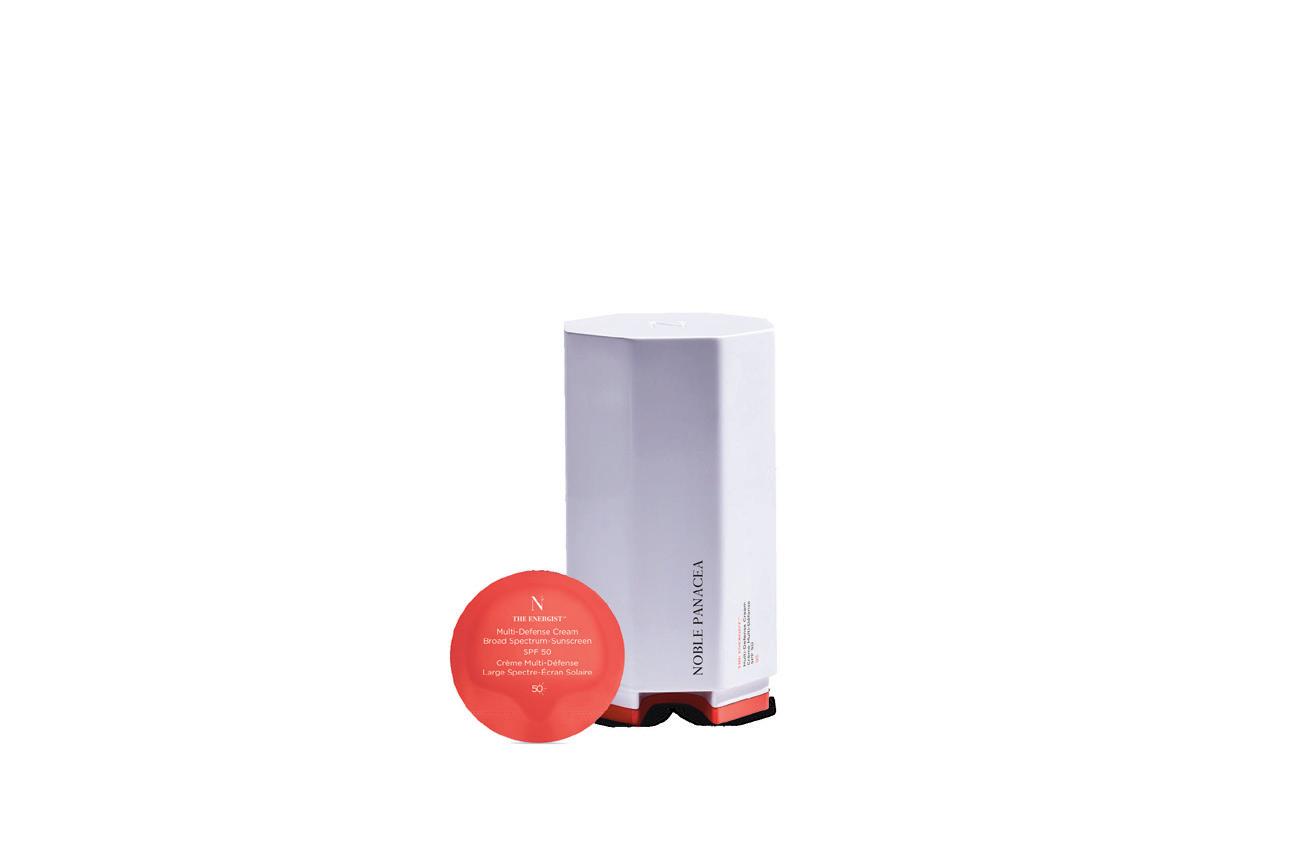

Marylebone Journal marylebonejournal.com
Marylebone Village marylebonevillage.com
Instagram: @marylebonevillage
Twitter: @MaryleboneVllge
Portman Marylebone portmanmarylebone.com
Instagram: @portmanmarylebone
Publisher LSC Publishing lscpublishing.com
Editor Mark Riddaway mark@lscpublishing.com
Advertising sales
Donna Earrey 020 7401 2772 donna@lscpublishing.com
Contributers
Jean-Paul Aubin-Parvu
Lauren Bravo
Ellie Costigan
Clare Finney
Orlando Gili
Emily Jupp
Viel Richardson
Design and art direction Em-Project Limited mike@em-project.com
Owned and supported by The Howard de Walden Estate 23 Queen Anne Street, W1G 9DL 020 7580 3163 hdwe.co.uk
annette.shiel@hdwe.co.uk
MARYLEBONE JOURNAL ISSUE NO.105
BROUGHT TO YOU BY THE HOWARD DE WALDEN ESTATE AND THE PORTMAN ESTATE
Published June 2024
The Portman Estate 40 Portman Square, W1H 6LT 020 7563 1400 portmanestate.co.uk rebecca.eckles@portmanestate.co.uk 3
HAPPENINGS IN MARYLEBONE
Events, exhibitions, film, music, shopping, talks, theatre and walks
14 IN PROFILE: MARINE TANGUY
The author and art agency CEO on how the visual environment affects our lives and what we can do to control its impact
20
LE STREET, C’EST CHIC
The Journal hits the high street to uncover the enduring secrets of French style
THE DIFFERENCE MAKERS
Louise Griew, CEO of Roald Dahl’s Marvellous Children’s Charity
Food, style, home, wellbeing and healthcare
The executive chef and managing director of Kima on Greek produce, the fin-to-gill concept, and the joys of a fish head
44 Q&A: CHARLIE CASELY-HAYFORD
The menswear designer on continuing his father’s design legacy, dressing Paapa Essiedu, and how the suit is being rebooted 46
STYLE PHILOSOPHY
Stacy Chan of Platform on collaborating with designers, telling stories, and dressing mainly in black 58
ANATOMY OF A DESIGN
Pascale and Francis Gelb of Sabre on a collection that sums up their French cutlery brand
1 — MARYLEBONE JOURNAL / ISSUE NO. 105
31
34 A CLOSER LOOK
34 Q&A: NIKOS
ROUSSOS
Cover: Charlie Casely-Hayford of Casely-Hayford by Marsy Hild



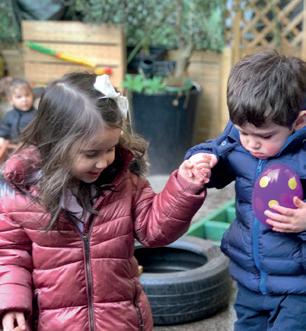




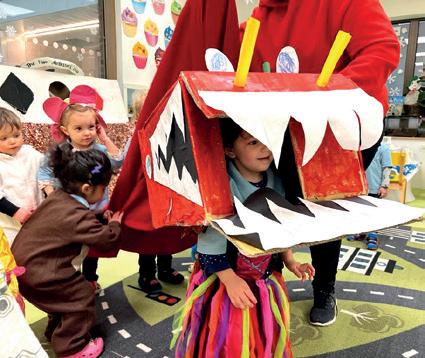
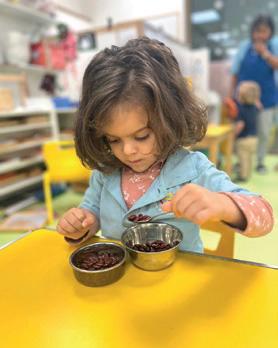
HOPE MONTESSORI SCHOOL NURSERY & BABY ROOM 3 Cramer Street, Marylebone, W1U 4EA Admin@HopeMontessoriSchool.com +44 (0) 7919 84 48 53 HopeMontessoriSchool.com
HAPPENINGS IN MARYLEBONE EVENTS EXHIBITIONS FILM
MUSIC SHOPPING TALKS THEATRE WALKS
MUSIC
25 JUNE, 7.30pm
PHANTASM
Wigmore Hall
36 Wigmore Street, W1U 2BP wigmore-hall.org.uk
As part of a season-long series marking the 400th anniversary of the death of William Byrd, one of England’s greatest composers, leading German viol consort Phantasm explores his work and its influence on the music of John Jenkins, William Lawes and Henry Purcell.
MUSIC
27 JUNE, 6.30pm
ACADEMY MANSON ENSEMBLE: BÁRA GÍSLADÓTTIR
Royal Academy of Music Marylebone Road, NW1 5HT ram.ac.uk
This free concert explores the fantastical world of Bára Gísladóttir, the Academy’s composer in residence, alongside the works of fellow Icelander Anna Thorvaldsdóttir and a premiere from Academy PhD student James Batty.
MUSIC
29 JUNE, 7pm
SOTIRIA’S SONGS
The Hellenic Centre 16-18 Paddington Street, W1U 5AS helleniccentre.org
Musical artist and actress Christina Maxouri is joined by four musicians for a programme that journeys through the life and songs of Sotiria Bellou, one of the 20th century’s most popular and influential singers of Greek ‘rebetiko’ folk music.
THEATRE
27 – 30 JUNE
SENECA’S OEDIPUS
The Cockpit Gateforth Street, NW8 8EH thecockpit.org.uk
Ted Hughes’s adaptation of Seneca’s Oedipus is given a modern re-telling by The Bridge Theatre Training Company. A pandemic devastates the city of Thebes, the population is decimated, the governing class has no answers. How can the curse be lifted?
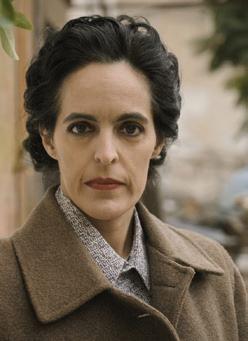


MUSIC
Returning for its fourth year, this series of free performances celebrates diversity in classical music. This year features the music of Mozart and Villa-Lobos alongside contemporary composers including Toshio Hosokawa, Théa Deacon and Mason Bynes.
25 & 27 JUNE, 1pm
SEEN & HEARD
Royal Academy of Music Marylebone Road, NW1 5HT ram.ac.uk
3 — MARYLEBONE JOURNAL / ISSUE NO. 105
HAPPENINGS IN MARYLEBONE
1. Christina Maxouri, The Hellenic Centre
2. Bára Gísladóttir, Royal Academy of Music
1. 2. 3.
3. Seen & Heard, Royal Academy of Music
EXHIBITION
From his base in Bruton, Somerset, Giles Penny creates highly distinctive works that cross the boundaries between sculpture, painting and printmaking. Mainly centred around the human figure and form, his art exudes an endearing sense of humour and innocence.
19 JUNE – 5 JULY
GILES PENNY
Thompson’s Gallery
3 Seymour Place, W1H 5AZ thompsonsgallery.co.uk

THEATRE
27 – 30 JUNE
ROYAL ACADEMY MUSICAL
THEATRE: INTO THE WOODS
Royal Academy of Music Marylebone Road, NW1 5HT ram.ac.uk
In this Sondheim classic, the baker and his wife wish to have a child, Cinderella wishes to attend the king’s festival and Jack wishes his cow would give milk. Wishes may be granted, but are the consequences of having ventured into the woods ultimately worth it?
FOOD
30 JUNE, 7pm
T BY TAMARA SUPPER CLUB
T By Tamara 17 Seymour Place, W1H 5BF tbytamara.co.uk
For this monthly event, Tamara Al Saadi’s lovely Levantine cafe stays open into the evening to host a ticketed supper club at which guests feast on a full spread of regional cuisine, accompanied by the sounds of a singer. The promise is of good food, good music and good company.
EXHIBITION
UNTIL 7 JULY
THE SECRET LIVES OF PLANTS
The Gallery of Everything 4 Chiltern Street, W1U 7PS gallevery.com
A collection of imagined flora and fauna from 20th century outsider artists: the otherworldly botany of Czech painter Anna Zemánková, the ceramics of American hobbyist Eugene von Bruenchenhein, and the monochrome impressions of English artist Madge Gill.
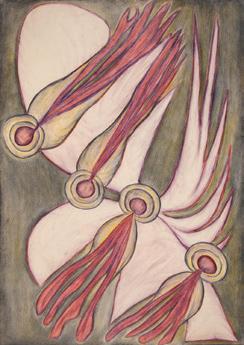
4 — MARYLEBONE JOURNAL / ISSUE NO. 105 HAPPENINGS IN MARYLEBONE
2.
1.

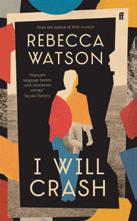
3, 4
TALK 11 JULY, 7pm

REBECCA WATSON
Daunt Books
83-84 Marylebone High Street, W1U 4QW dauntbooks.co.uk
Rebecca Watson comes to Daunt to discuss her powerful new novel, I Will Crash, which explores the universal themes of love, grief and forgiveness with refreshing candour. For her Q&A, she is joined by bestselling novelist Monica Heisey, author of Really Good Actually.
TALK
16 JULY, 7pm
DONNA LEON
Daunt Books
83-84 Marylebone High Street, W1U 4QW dauntbooks.co.uk
Donna Leon, Swiss American author of the bestselling Commissario Brunetti mystery series, returns to Daunt Books for a Q&A to celebrate the publication of A Refiner’s Fire, the latest in this long sequence of sophisticated Venice-set detective novels.
EVENT
In the middle of the summer, Portman Square Garden is being opened up to the public for six days for a free event that offers the opportunity to spend time in one of central London’s most beautiful and tranquil settings. The event, run by the Baker Street Quarter Partnership, takes place in the final week of Wimbledon, and the tennis can be viewed on a big screen (ideally from a deck chair with a drink in hand). Refreshments will be available from high-quality street food stalls as well as a guest kitchen, sponsored by Portman Marylebone, where chefs from popular local restaurants will be on rotation, cooking up some of their signature dishes.
9 – 14 JULY SUMMER IN THE SQUARE Baker Street Quarter Partnership makeitmarylebone.co.uk
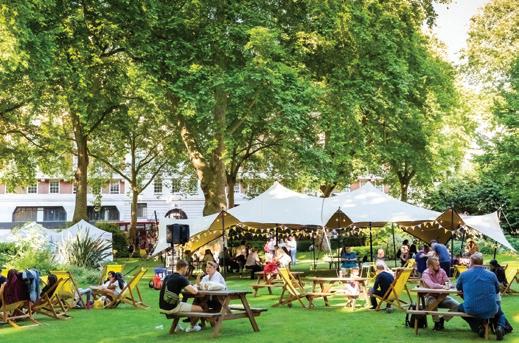
5. MUSIC 17 JULY, 7.30pm CHRISTIAN MCBRIDE Wigmore Hall 36 Wigmore Street, W1U 2BP wigmore-hall.org.uk
Legendary American jazz bassist, composer and arranger Christian McBride, winner of eight Grammy Awards, is joined by the similarly feted guitarist Kurt Rosenwinkel for a very special collaboration.

6.
5 — MARYLEBONE JOURNAL / ISSUE NO. 105
1. Man Who Knows the Way by Giles Penny, Thompson’s Gallery
2. Untitled by Anna Zemánková, The Secret Lives of Plants, Gallery of Everything 3. Rebecca Watson, Daunt Books
4.
Donna Leon, Daunt Books
5.
Summer in the Square
6. Christian McBride, Wigmore Hall
HAPPENINGS IN MARYLEBONE
EXHIBITION
UNTIL 19 JULY
MAYA ERIN MASUDA: SLEEP, LICK, LEAK, DEEP….
Daiwa Anglo-Japanese Foundation
13/14 Cornwall Terrace, NW1 4QP
dajf.org.uk
The first UK solo show by Tokyo-born, Berlin-based interdisciplinary artist Maya Erin Masuda explores ecological trauma, biopolitics, nuclear catastrophes and the precarious nature of the planet.

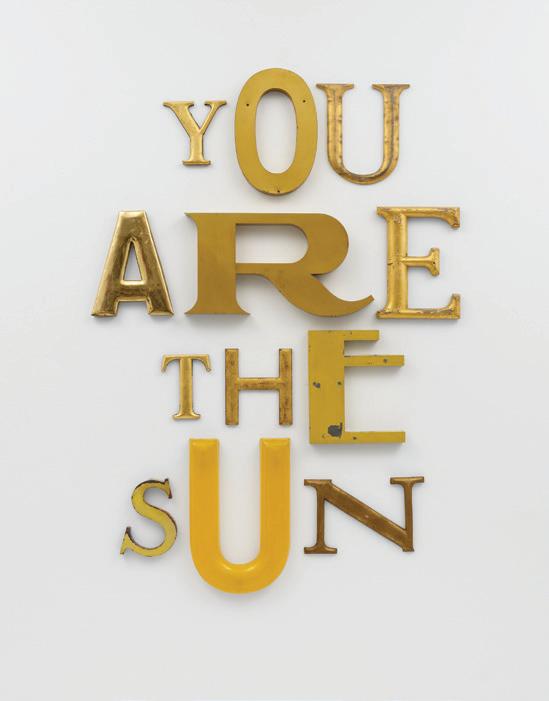
EXHIBITION
New York-based artist Jack Pierson, who emerged from the 1980s Boston school of documentarian photographers before moving into punk-infused collage and sculptural assemblage, presents new works, featuring his signature word sculptures, photographs, prints, paintings and found posters.
UNTIL 3 AUGUST
JACK PIERSON
Lisson Gallery 67 Lisson Street, NW1 5DA lissongallery.com
THEATRE 2 – 20 JULY
MEDEA GOSPERIA
The Cockpit Gateforth Street, NW8 8EH thecockpit.org.uk
Produced by Thee Black Swan, this tense, emotional collision of drama, jazz and gospel opera is based on Euripides’ Greek tragedy Medea. Set in the Caribbean with a multiracial cast, the performance embraces the ancient Greek tradition of fusing action with commentary and debate.
MUSIC
20 JULY, 11.30am, 3pm, 7.30pm AFRICAN CONCERT SERIES
Wigmore Hall
36 Wigmore Street, W1U 2BP wigmore-hall.org.uk
Created by pianist Rebeca Omordia, this day of concerts places the spotlight on musicians born or rooted in Africa. The first explores African woodwind, the second highlights north African music, and the third sees Imbube Singers join Lichfield Gospel Choir for an evening of song.

THEATRE
This new stage version of Frances Hodgson Burnett’s classic children’s tale tells the story of 10-year-old Mary Lennox, who’s sent to live with an uncle she’s never met at Misselthwaite Manor in Yorkshire. There, she discovers a mysterious garden as lost and neglected as she is.
UNTIL 20 JULY
THE SECRET GARDEN
Regent’s Park Open Air Theatre Regent’s Park, NW1 4NU openairtheatre.com
6 — MARYLEBONE JOURNAL / ISSUE NO. 105
1. You Are the Sun by Jack Pierson, Lisson Gallery
2. Pour Your Body Out by Maya Erin Masuda, Daiwa AngloJapanese Foundation
3. The Secret Garden, Regent’s Park Open Air Theatre
4. Rebecca Omordia, African Concert Series, Wigmore Hall
5. Eugene Rogan, Daunt Books
3. HAPPENINGS IN MARYLEBONE 1.
2.


TALK 22 JULY, 7pm
EUGENE ROGAN
Daunt Books
83-84 Marylebone High Street, W1U 4QW dauntbooks.co.uk
The Damascus Events, the new book by American historian Eugene Rogan, examines the pivotal importance of the 1860 massacre of Christians in Damascus. For his Q&A, he is joined by fellow author and BBC News international editor Jeremy Bowen.

7 — MARYLEBONE JOURNAL / ISSUE NO. 105
HAPPENINGS IN MARYLEBONE
5.
4.
Q&A: MANDY ZHANG
The eponymous owner of Mandy Zhang Art on emerging Asian artists, cross-cultural dialogue and the importance of philosophy
Interview: Emily Jupp
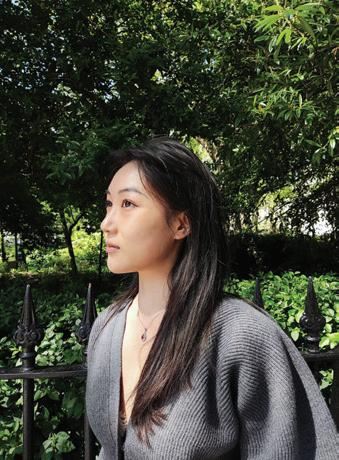
Q: Having recently opened on Seymour Place, have you made friends with your neighbours?
A: Yes! I’ve lived on this street for two years, so I already knew some of the shop owners. I go to So French for coffee and I love the owners there. Every week I go either to Donostia or Lurra for Spanish food. I just love Marylebone so much. The vibe is perfect for me. I’m very lazy, I don’t really want to travel very far and Marylebone is very central, but not too noisy, not too crowded. I can still get everything I want here – and it has a village feel to it.
Q: What brought you to London?
A: I’m originally from China –Chengdu, Sichuan, the spicy food area! I’ve been in the UK since 2019 when I came here for my master’s at the Royal College of Art, where I studied contemporary art curation. We got the chance to make things, do physical projects and make exhibitions happen. I took a year off because I didn’t want to do the whole pandemic, online thing, so I graduated in 2022. I already knew then that I wanted to start a platform to support Asian artists.
Q: Is your gallery covering the entire Asian continent?
A: So far, we’ve been working with east Asian and south Asian artists, but we’re looking to collaborate with more middle Asian artists: Kazakhstan, Mongolia. I was in touch with an artist earlier this year from Kazakhstan, and their work is just so, so cool! You can see that they seek inspiration from Western art, but not that much. It’s so different.
Q: Do you make art yourself?
A: No. Not at all. Maybe I shouldn’t say this, because it’s not a very good image of my home country, but I’m going to tell it anyway. In China, there’s a very weird and not nice judgement about people doing

art. In parents’ minds, especially the older generation, you only do art because you can’t do well academically. It’s sad. I studied philosophy because it was a good middle ground for me and my parents. I wanted to do art. I knew through this path, I could get there eventually.
Q: What did you gain from studying philosophy?
A: The way to see the world, to learn the world, and to think about everything in a more rounded way. Philosophers are always trying to find the ultimate power behind everything, to explain how the world runs. Nowadays, people care about practical issues, which probably matter more in real life. But those great thoughts have existed for thousands of years and they’re still important.
Q: How does that relate to art?
A: I think art has the potential to live that long – thousands or tens of thousands of years. And it’s also not just the visual, but the concept, the idea of the art behind it.
Q: What are the ideas that you want to explore?
A: At the moment, I’m focusing on cross-cultural dialogue because a lot of the artists I work with, they have experience of living in both Asia and Western places. So their life experience itself is a crosscultural thing.
Q: Are there any culture clashes that you come across in your dayto-day life here?
A: Oh, a lot! It’s a very different culture. I couldn’t do English irony. When my friend and I go out for dinner, he will finish his whole plate and say: “I hate this.” The first time I heard it, I was like: “What are you talking about?” And it’s very funny, because when we went to China, he tried to do the same at the Chinese table. And the waitress
8 — MARYLEBONE JOURNAL / ISSUE NO. 105
HAPPENINGS IN MARYLEBONE 1. 2.
was just like... horrified. She was afraid he was going to ask for a refund! I’m getting used to it now.
Q: Tell us a bit more about the capacity of art to bridge that cultural gap. Does it? Can it?
A: I think great art should speak for itself. Currently we have a display by an artist called Can Sun – it’s his first solo exhibition in the UK and it’s deeply rooted with his Chinese background. But you have no difficulty understanding the work, right? It should be open to different interpretations. For example, there’s a photograph of a lattice of cigarettes, interwoven like a cushion. The artist is trying to say through that work that every one of us is like those cigarettes. We’re interwoven with each other in society. We’re burning ourselves to give out something. At the same time, we might hurt each other, but we can’t really escape the hurt. It is a tiny bit sad, but there are people seeing it as: “Oh, a cushion. Very cute.” And there’s an art critic who came one day and wrote a review guessing that the artist had a problem quitting smoking. Every interpretation makes sense, and I love it.
Q: Covid unlaunched a wave of racism targeting east Asian communities. Did that affect you?
A: That’s one of the reasons why I wanted to start doing this, because the discrimination against Asians was bad around the same time as the Black Lives Matter movement. I was seeing Black people supporting each other and creating this huge movement, but Asian people are not that together yet. I feel like I should do something. I want to support my people. I want to support the culture I’m standing in.
UNTIL 7 JULY
SILIA KA TUNG: GREEN ROCK AND THE MAGIC MOUNTAIN
Mandy Zhang Art 16 Seymour Place, W1H 7NG mandyzhang.art

1. Mandy Zhang
2 Silia Ka Tung, Mandy Zhang Art
3. Fleur Barron, O/Modernt Chamber Orchestra, Wigmore Hall 3.
MUSIC
22 JULY, 7.30pm O/MODERNT CHAMBER ORCHESTRA
Wigmore Hall
36 Wigmore Street, W1U 2BP wigmore-hall.org.uk
Led by violinist Hugo Ticciati and fronted by mezzo-soprano Fleur Barron, members of the relentlessly creative O/Modernt orchestra (‘Un/Modern’ in Swedish) bring together works from a varied group of French composers, plus the Japanese Toru Takemitsu.
EXHIBITION
UNTIL 3 AUGUST
THE LEISURE CENTRE
The Brown Collection
1 Bentinck Mews, W1U 2AF glenn-brown.co.uk
This exhibition combines Glenn Brown’s own works with those of artists past and present whose paintings and sculptures have become part of his personal collection. The title, he says, questions not so much what a leisure centre is but where the centre of our leisure might be found.
9 — MARYLEBONE JOURNAL / ISSUE NO. 105
HAPPENINGS IN MARYLEBONE
EXHIBITION
Terrence Donovan helped define the look of 1960s London, documenting the people and places that made it swing. One of the first British photographers to find fame, he continued as a chronicler of fashion, pop culture and commerce long after the sixties were over. Bringing together works that span from 1959 to 1995, this exciting exhibition surveys the breadth of his remarkable career, including fashion, advertising, celebrity, photo essays and personal projects.
UNTIL 7 SEPTEMBER
TERRENCE DONOVAN
Atlas Gallery
49 Dorset Street, W1U 7NF atlasgallery.com
EXHIBITION
UNTIL 3 AUGUST
OTOBONG NKANGA
Lisson Gallery
27 Bell Street, NW1 5BY lissongallery.com
Otobong Nkanga’s inaugural Lisson Gallery exhibition includes drawings created at both large and small scale, as well as new sculptural objects: stacked and striated columns of ceramic vessels, and wallhung and floor-based works that combine rope, glass, oils and tactile materials.

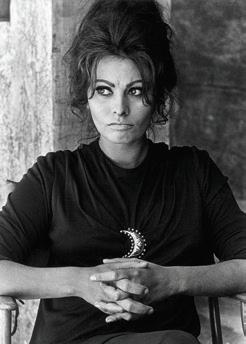
30 JULY – 4 AUGUST
THE SECRET GARDEN SERIES
St John’s Lodge Garden Regent’s Park, NW4 1NY regentsparkmusicfestival.org.uk
As part of this year’s Regent’s Park Musical Festival, the beautiful St John’s Lodge Garden – the titular secret garden – hosts a series of intimate concerts, including opera, musical theatre, classical musical and a childfriendly performance of The Pied Piper.
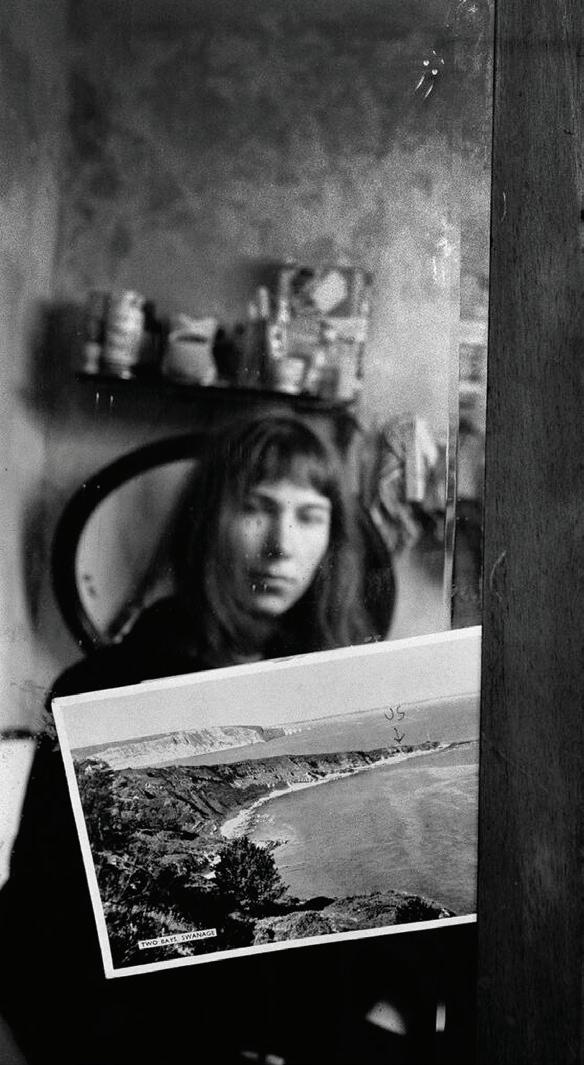
THEATRE
29 JULY – 25 AUGUST
THE CAMDEN FRINGE 2024
The Cockpit Gateforth Street, NW8 8EH thecockpit.org.uk
The Camden Fringe offers performers from a wide range of disciplines, including drama, comedy, dance and poetry, the chance to present new material in a festival setting, without the time and money needed to take a show to Edinburgh. The Cockpit will, as always, be one of the main venues for the festival.
4.
10 — MARYLEBONE JOURNAL / ISSUE NO. 105
1. Julie Christie by Terrence Donovan, Atlas Gallery
2. Sophia Loren by Terrence Donovan, Atlas Gallery
3. The Layabout Life by Terrence Donovan, Atlas Gallery
Between Embers and Ashes y Otobong Nkanga, Lisson Gallery
5. The Elm Tree, Marylebone Lane Theatre
HAPPENINGS IN MARYLEBONE
1.
2. 3.
THEATRE


NEW
The junction of Marylebone Lane and Wigmore Street, which sits on one of the main pedestrian routes up from the West End, is one of the most natural entry points into Marylebone Village. Here, visitors to the area will now be greeted by an eye-catching new installation. Made from fully recyclable materials, The Elm Leaf is inspired by the presence on the high street of London’s oldest surviving elm tree. These magnificent native trees were once a commonplace fixture of London’s streetscape, but those that weren’t chopped down during decades of urban redevelopment were wiped out in the 1970s by the ravages of Dutch elm disease. The Marylebone tree lives on, connecting the village to its rich history. To celebrate the arrival of the artwork, the lane’s community of independent retailers came together for a group portrait.
THE ELM LEAF Marylebone Lane marylebonevillage.com
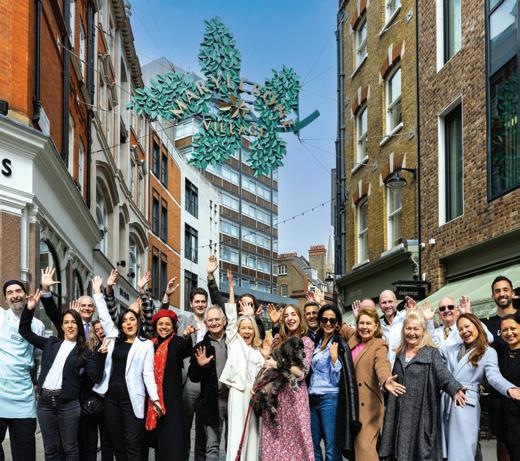
THEATRE 28 AUGUST – 1 SEPTEMBER
THE UNLIKELY SECRET AGENT
Marylebone Theatre 35 Park Road, NW1 6XT marylebonetheatre.com
In 1963, Eleanor, an unassuming young mother, is taken for questioning by South African police searching for her ‘terrorist’ lover, Ronnie. The officers set about trying to break her will, unaware that this seemingly nervous young woman is an ANC agent – and she’s plotting her escape.
MUSIC
15 SEPTEMBER, 11.30am
CHIAROSCURO QUARTET
Wigmore Hall
36 Wigmore Street, W1U 2BP wigmore-hall.org.uk
Chiaroscuro Quartet, a young multinational foursome who play on gut strings using early 19th-century bows in pursuit of period authenticity, offer their distinctive perspective on Mozart’s String Quartet No 15 in D minor K421 and Schubert’s String Quartet in A minor D804 ‘Rosamunde’.
11 — MARYLEBONE JOURNAL / ISSUE NO. 105 HAPPENINGS IN MARYLEBONE
4.
NEW 5.
MUSIC
15 SEPTEMBER, 7.30pm
BORIS GILTBURG
Wigmore Hall
36 Wigmore Street, W1U 2BP wigmore-hall.org.uk
For the first of his series of autumn concerts devoted to Beethoven’s sonata cycle, acclaimed Israeli pianist Boris Giltburg takes on the composer’s ‘Hunt’ sonata of 1802, whose use of hunting motifs in its finale earned its nickname, and the mighty ‘Hammerklavier’ from 1818.

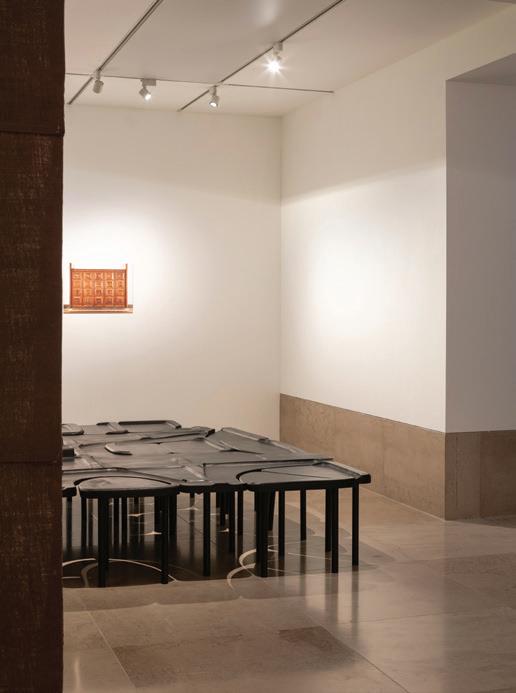
EXHIBITION
In this important exhibition, new works by artists Giles Tettey Nartey, Arinjoy Sen, Thandi Loewenson, Zhongshan Zou and Esi Eshun explore the deeply uncomfortable images and narratives contained within the Jarvis Mural and Florence Hall Dominion Screen at RIBA’s headquarters – two 1930s pieces that celebrate British imperialism.
UNTIL 21 SEPTEMBER
RAISE THE ROOF: BUILDING FOR CHANGE RIBA
66 Portland Place, W1B 1AD architecture.com
THEATRE
27 JULY – 21 SEPTEMBER
FIDDLER ON THE ROOF
Regent’s Park Open Air Theatre Regent’s Park, NW1 4NU openairtheatre.com
With timeless songs including If I Were A Rich Man, Jerry Bock’s exuberant 1971 musical tells the story of Tevye, a Jewish milkman in Imperial Russia, whose five strongwilled daughters challenge his old-fashioned beliefs as he attempts to push them into traditional marriages.
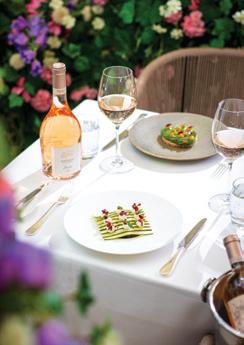
FOOD
UNTIL END OF SEPTEMBER
ORRERY TERRACE
55 Marylebone High Street, W1U 5RB orrery-restaurant.co.uk
One of the fleeting treats of a Marylebone summer is the availability through the warmer months of Orrery’s beautiful rooftop terrace, which is open for dining until the end of September. Offering the sense (and scents) of a Provençal garden, the space is lined with lavender and olive trees – an association enhanced through a collaboration with Maison Mirabeau, makers of exceptional Provence rosé. In addition, the neighbouring Orrery Epicerie will be staying open until 9pm throughout the summer, offering new food and drink menus, making it a spot to enjoy a cold glass of wine in the evening as well as a coffee in the daytime.

EXHIBITION
18 SEPTEMBER – 4 OCTOBER
AUTUMN ANNUAL Thompson’s Gallery
3 Seymour Place, W1H 5AZ thompsonsgallery.co.uk
This annual show features a richly varied selection of new works from some of Thompson’s Gallery’s most popular artists, from Thembelethu Manqunyana’s punchy portraits to Stephanie Rew’s intricate gold leaf panels, to Matthew Draper’s serene pastels.
EXHIBITION
10 APRIL – 20 OCTOBER
RANJIT SINGH: SIKH, WARRIOR, KING
The Wallace Collection Manchester Square, W1U 3BN wallacecollection.org
Through over 100 exquisite artworks, including jewellery and weaponry, this major exhibition explores the life and personality of the great Sikh leader Ranjit Singh, who in the early 19th century conquered the Punjab and became its undisputed Maharaja.
12 — MARYLEBONE JOURNAL / ISSUE NO. 105
1.
1. Raise the Roof, RIBA
2. Boris Giltburg, Wigmore Hall
3. Orrery Terrace
4. Stephanie Rew, Autumn Annual, Thompson’s Gallery
HAPPENINGS IN MARYLEBONE 2. 3. 4.


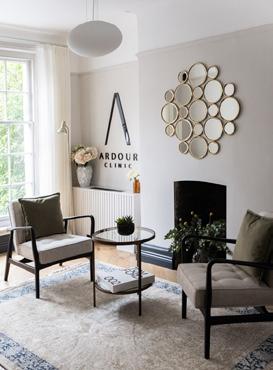
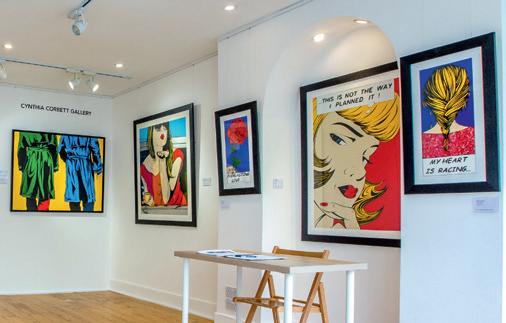
www.67yorkstreetgallery.com
Email: info@67yorkstreet.com
@67yorkstreetgallery
Doctor-led injectables
Bespoke facials
Hormone optimisation
Regenerative therapies
Body contouring

Elliott House 28a Devonshire Street, W1G 6PS Tel: 020 4553 5516 www.theardourclinic.com
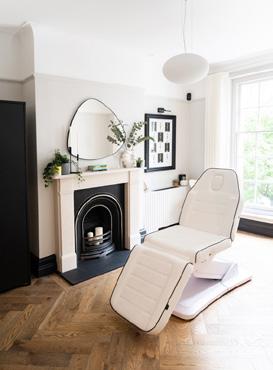

13 — MARYLEBONE JOURNAL / ISSUE NO. 105 THE MARYLEBONE INDEPENDENT GALLERY SPACE YOU NEED TO KNOW ABOUT
DISCOVER THE FINEST CONTEMPORARY PRACTITIONERS IN DESIGN, CRAFT AND ART AT 67 YORK STREET GALLERY
New to Marylebone THE ARDOUR CLINIC
Medical Aesthetics Life Coaching Wellbeing
IN PROFILE
MARINE TANGUY
The author and art agency CEO on how the visual environment affects our lives and what we can do to control its impact
Words: Mark Riddaway
Portraits: Romy Becker, Katrina Holmes
14 — MARYLEBONE JOURNAL / ISSUE NO. 105
IN PROFILE: MARINE TANGUY
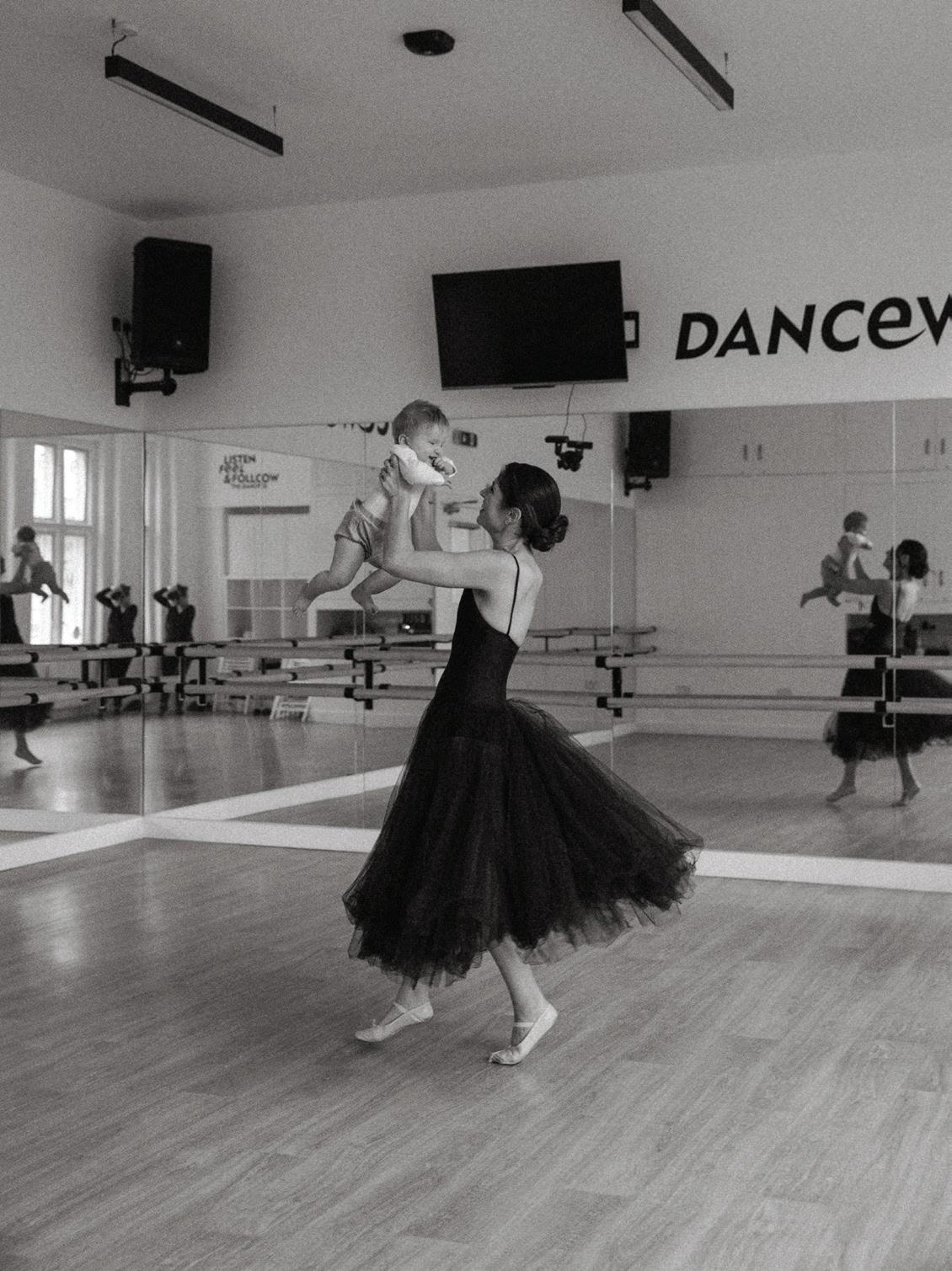
15 — MARYLEBONE JOURNAL / ISSUE NO. 105 IN PROFILE: MARINE TANGUY >
Ten thousand images. That, Marine Tanguy states, is the barrage of visual flak that whistles down your optic nerves and peppers your cerebral cortex, every single day. And that’s just the output of a smartphone. Factor in billboards and hoardings, magazines and newspapers, posters and public artworks, and the number of images we’re exposed to, mostly uninvited, reaches an even more stratospheric figure. This, she explains in her soft French accent, is probably not a good thing.
Marine is the founder and CEO of MTArt Agency, a pioneering Marylebone-based talent agency for visual artists. She is also the author of a recently published book that explores the dangers inherent to this largely unfiltered flow of imagery. Entitled The Visual Detox, it aims to make us more alert to the visual world in which we live, increase our understanding of its impact, and help us temper its effects. “It’s the sheer scale,” she says. “That’s the problem. I want to make you aware of something that is all around you and is only increasing.”
We all exist, she says, “in a sea of things that are hitting our subconscious and manipulating us.” The problem is that we don’t yet have the tools to mitigate the impact of this ocular bombardment. In fact, we barely notice it’s happening. “It’s like the fish in the water, right? You are swimming in it all the time, so you don’t even know it’s there. We need to help you swim in an environment that you understand and can control. That’s where visual literacy is important.”
Humans are visual creatures, and what we see – even subconsciously – can have a powerful influence on our thoughts and feelings. Commercial imagery is carefully formulated to fire our appetites and prime us to spend money on things we probably don’t need. Meanwhile, social media algorithms favour emotionally manipulative images that, while making us feel terrible, drive the online engagement that
makes Silicon Valley rich, triggering envy, anger, fear, contempt, and insecurity at the shape of our bodies or the contents of our bank accounts. At its best, though, our visual environment can be funny, uplifting or profound: a boon to our mood, not a maddening drag.
The act of looking can, as Marine has known since childhood, provide much-needed comfort and escape. She grew up in a rural community on Île de Ré, an island off the Atlantic coast of France. Her parents, both schoolteachers, were, she says, rather austere socialists who thought “art and literature were fluffy and elitist. For my dad, if I was a good student, I should’ve done maths and science.” It wasn’t a cheery household – her mother, who struggled with depression, was a compulsive tidier, and their home was a dark, spartan space – so Marine sought refuge in whatever aesthetic stimulation she could find. “My visual environment became a coping mechanism,” she says. “When I was little, I tuned in to the fact that if I went for a walk and looked at beautiful things, I felt better. If I sat in a beautiful forest, I felt better. I worked out that I could change my room, and that would make me feel better.”
She also found relief in books. “I was quite 19th-century obsessed: Flaubert and all those people,” she says. She would lap up stories about the salons of Paris, the “amazing dinners with artists, entrepreneurs, politicians, leading the conversation, being the pulse, shaping society”. And it was to dinner like those, she decided, that she wanted her life to take her. “I wanted to be in these places where you could just hear all these amazing ideas all night long.” Just one snag: “Obviously, I didn’t know what that looked like, jobwise.”
A good starting point seemed to be studying philosophy, but in her home country this rather limited her employment possibilities. “In
“On most of the public art committees we’re on, I see one person turning up representing the full neighbourhood – one person who has one strong opinion about something. Nobody else comes.”

France, I could only be a politician or a professor out of those studies, which I didn’t want to be.” England, she decided, would be freer. “I still hadn’t figured out what job I should do to get to those dinners, but London seemed to be full of great brains from everywhere. And also, dear Boris Johnson, who was Mayor of London at the time, was saying to foreigners: ‘Please come to London.’ Which obviously has changed now,” she says, smiling wryly.
Marine managed to land an internship at the BBC, working on The Culture Show – an experience she adored (“I love all the values the BBC stands for”). Through that,
IN PROFILE: MARINE TANGUY 16 — MARYLEBONE JOURNAL / ISSUE NO. 105
she met Andrew Lamberty, the art dealer and television presenter, who paid her to help him out at LAPADA Berkeley Square, an upper-crust jamboree of art and antiques. “Andrew was much more into the parties than he was into running his tent,” she says. “He basically let me manage it, even though I was only 19, having never done design in my life.” Thrust into the tweedy, moneyed milieux of antique art collectors, she experienced none of the class-bound inhibitions that might cripple an English teenager from a similar background, and was able to charm her way to sales, connections and some of those high-brow dinner conversations she’d dreamt of.
Her obvious vim brought Marine to the attention of Steve Lazarides, a gallerist and promoter who was instrumental in the popularisation and monetisation of street art, helping to bring artists such as Banksy and Invader to prominence, and he persuaded her to take a job as manager of The Outsiders, his gallery on Soho’s Greek Street. “I went from LAPADA Berkeley Square to street-art bro culture, which you can imagine is quite a bit of a transition,” she says. “LAPADA taught me about inherited wealth and power dynamics. But Steve broke the codes at every level. He taught me that you could break a lot

of those rules and invent your own.”
Marine’s life changed again when Steph Sebbag, the wealthy, art-loving founder of the BPG advertising agency, wandered into The Outsiders, bonded immediately with its effervescent French manager and, over dinner that same day, suggested they start a new venture together – in America. “I was 23, with nothing to lose whatsoever, but completely out of my depth once again,” she recalls. At the drop of a hat, Marine moved from London to Los Angeles to open the De Re gallery, named after her birthplace. It launched amid a blizzard of publicity in May 2014.
The experience was a bewildering one. “I had the weirdest social interactions in that period –everyone was either a celebrity or a billionaire, but I was completely broke,” says Marine. “Demi Moore was there at the opening. Michael Ovitz [the Hollywood powerbroker] thought it curious that this 23-yearold was being catapulted to do this gallery and asked to meet me. I was very confused about the LA art scene – I think most people still are to this day.” The excitement soon abated – Marine had fantasised of dinners with Flaubert, not selfies with celebs – but the experience proved highly formative. “I was exposed to this celebrity culture that I had never dreamed of, but I could see it was shaping everything that we were
consuming on a daily basis.”
“That was the birth of MTArt,” she continues. In the couple of years she spent in LA, Marine saw up close how entertainment, celebrity and social media shape our visual culture. Now she wanted to claim some of that cultural real estate for the artists she knew and loved. Her plan was to find ways of seeding art beyond the traditional spaces of galleries and auction houses, while borrowing from the model that makes talent agencies such vital cogs of the entertainment engine.
From its office on Mandeville Place, MTArt Agency seeks opportunities for the contemporary artists on its roster to gain income and exposure from commercial partnerships and public commissions. “Where the traditional art world sees art as objects, we see it as visual storytelling,” Marine explains. “A gallery exhibition is one way for an artist to express that story, but doing a big public sculpture in the centre of a city is another way, doing a digital collaboration is a third way, brand collaboration is a fourth way, entertainment collaborations would be a fifth way. It’s our job to then create opportunities for that visual expression to be integrated in all those different environments.”
Marine sees her work as a way of taking art beyond the enclosed
IN PROFILE: MARINE TANGUY 17 — MARYLEBONE JOURNAL / ISSUE NO. 105 >
Right: An MTArt public art project in Delhi, India, featuring an installatio by Sajid Wajid Shaikh Below left: Marine Tanguy
world where creative endeavour is privatised and commoditised, “a world where 90 per cent of people have inherited wealth and the focus is on preserving or increasing that wealth”. In Marine’s dealings with clients, the currency of success is almost always eyeballs, not sales, so the incentive is to make the art visible to as many people as possible. “I don’t need you to insert any money. Your interaction with the art validates the decisions we’re making,” she explains. “As a gallery owner or a gallery assistant at the front desk, you’re there to sell the art, you know? But in our model, everyone is adding value. There are many reasons that exposure to the arts is beneficial for society at large, so our win as a business is also a win at a society level.”
Which brings us back to those 10,000 images a day. Marine’s thought-provoking debut book makes the case that while exposure to the arts is beneficial to society, exposure to a relentless assault of unfiltered imagery designed to shape our behaviours and stimulate our desires is categorically not. Her proposed solution to this problem has three parts: awareness, visual literacy and participation. She wants us to be more aware of the extent of our exposure, more conditioned to understanding its impact on our mental health and behaviour, and more active in curating the visual content we’re fed both in private and in public.
“Every day, we’re targeted with images that reflect and harden biases around race, religion, age, disability, social economics and gender,” she says. “I showed an example yesterday, because I always take pictures, and there was a snack bar, very random, by Euston station, advertised with this woman, half naked, on either side of the snack bar. And there’s no reason – there’s no correlation with the snack bar. You might think, Oh, it’s just an image, it’s fun, it’s not really important. But, deep
“With social media, you need to know that you’re feeding a beast that is ultimately harming people. There’s a big degree of participation that we can take. You clicking on things is never just a click.”

down, we’re saying to girls: ‘Your appearance is what defines you over anything else.’ In advertising, women are four times more likely than men to be in revealing clothing. That has an effect.”
Social media amplifies and monetises those very same biases.
As an example, Marine tells the depressing story of an experiment in which she shared on Instagram a deliberately stereotypical image of her bikini-clad rear set against an idyllic swimming pool scene – a deliberately narcissistic semi-nude that, supercharged by the algorithm, had within a matter of hours completely outstripped the reach

and engagement she’d received for the hundreds of images of art, artists and female achievement that make up the rest of her output.
To improve the visual landscape, she suggests we take steps to ensure our phones are feeding us imagery that makes us feel good about ourselves and the world. She also wants us to be more mindful of the way we engage with that imagery. “It’s knowing that you’re feeding a beast that is ultimately harming people,” she says. “There’s a big degree of participation that we can take. You clicking on things is never just a click. With social media, I always say to my girlfriends, if you commented on 10
18 — MARYLEBONE JOURNAL / ISSUE NO. 105 IN PROFILE: MARINE TANGUY
Black Renaissance, a work by MTArt artist Rayvenn D’Clark, at Freedom Monument Sculpture Park, Alabama
Below left: Hunter, a painting by MTArt artist Stefania Tejada

pictures of your friend saying she’s beautiful but every time she shares an achievement you don’t comment, you’re reinforcing that culture. If you click on clickbait, you keep reinforcing that those biases sell.”
Similarly, she thinks we should be more active in shaping the public art we encounter on our streets. Many public art commissions include a consultation process, but such is the general level of apathy, these are often essentially meaningless. “On most of the public committees we’re on, I see one person turning up representing the full neighbourhood – one person who has one strong opinion about something,” says
Marine. “Nobody else comes.”
The sudden appearance of public art as a topic of discourse in the wake of the Black Lives Matters protests was, she believes, a cause for hope. “For the first time, people were like: ‘What I see represents me, and I don’t want that statue to represent me.’ I think that’s a really strong democratic statement. I’m not pro pulling down sculptures – I think you need to have the conversation at large before you take down any monument. But I think that burst of anger was so important – it was people realising that their city is their space.”
Marine sees similar shoots of
promise in the outrage that has seen some female body-shaming advertising campaigns rapidly canned. And while there are still more statues of Paddington Bear in London than there are of Black women, representation in public spaces is at least now on the agenda. “If you start saying, ‘I have a problem with this,’ politicians and businesses will start paying more attention to it,” she concludes. “We just need to make it feel more and more problematic.”
MTART AGENCY
3 Mandeville Place, W1U 3AP
mtart.agency
19 — MARYLEBONE JOURNAL / ISSUE NO. 105 IN PROFILE: MARINE TANGUY
LE STREET,
As a new wave of Parisian fashion brands strolls insouciantly into Marylebone Village, the Journal hits the high street to uncover the enduring secrets of French style
Words: Lauren Bravo
20 — MARYLEBONE JOURNAL / ISSUE NO. 105
LE STREET, C’EST CHIC
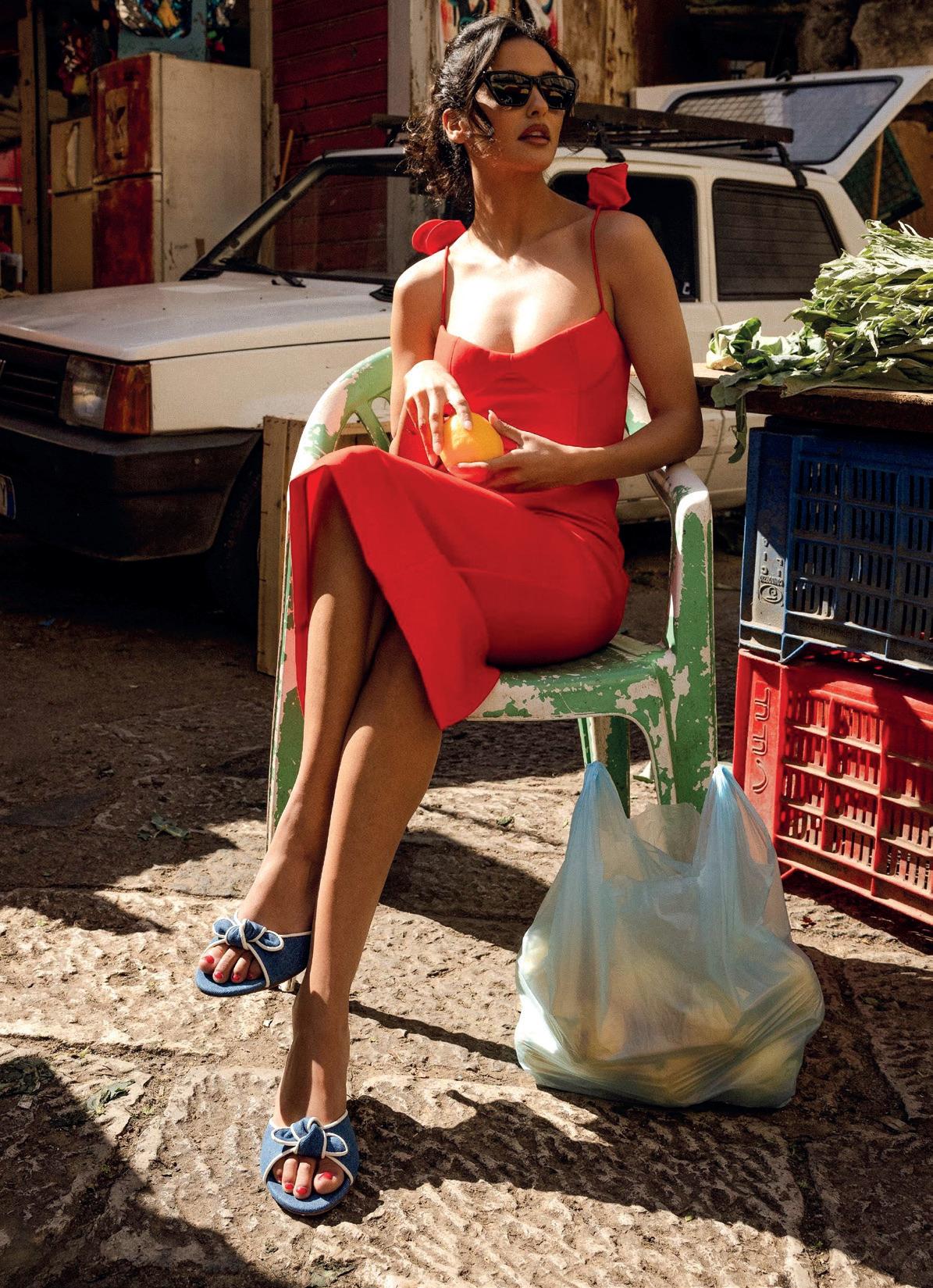
C’EST CHIC
21 — MARYLEBONE JOURNAL / ISSUE NO. 105 >
LE STREET, C’EST CHIC
A model wearing Sophia mules from the Bobbies footwear brand, designed in collaboration with Juny Breeze
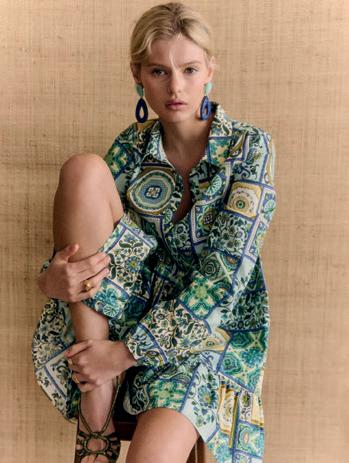
In all of fashion’s fickle history, there are perhaps few tropes as steadfast and enduring as the legend of The French Woman.
Considerable chunks of popular culture have been devoted to studying her. Her charming insouciance, her instinctive chic; her invisible makeup and her ability to look good in the rain. Her weapons of choice? A trench coat, crisp white shirt and perpetually lit cigarette. Her secret? If only we knew.
Some claim she is a myth or an outdated stereotype; that the narrow image of a certain type of Parisienne – feminine yet gamine, usually white, exclusively thin despite the omnipresent baguette in her basket bag – is no more representative of modernday France than the royals are of contemporary Britain. Or that she’s a mere figment of the tourist imagination, existing only in contrast to brash outsiders (think Carrie Bradshaw falling over in Dior, or the titular Emily in Paris mispronouncing pain au chocolat in a monogrammed bucket hat).
Yet, she lives on. That elusive je ne sais quois continues to inspire writers, filmmakers, designers and more TikToks than you can shake a bold red lipstick at. She has a long (and long-limbed) lineage that stretches from Juliette Gréco and Françoise Hardy via Vanessa Paradis
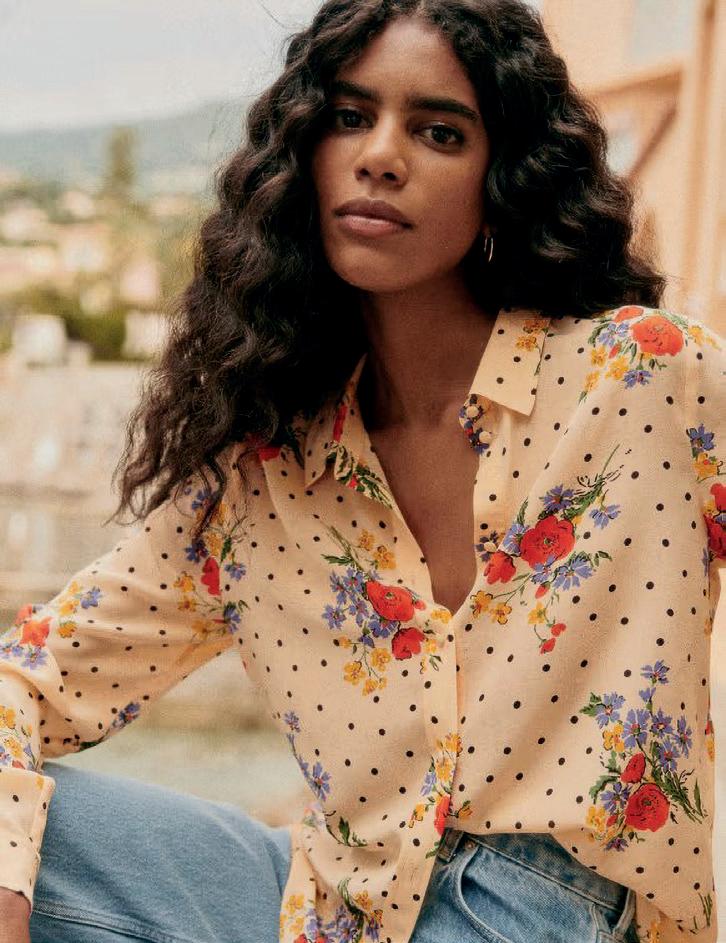
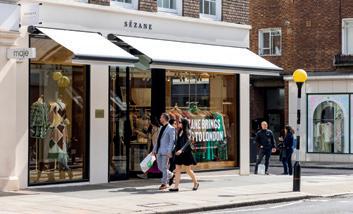
and Charlotte Gainsbourg, to cult social media influencers Jeanne Damas and Camille Charrière – and now our pocket of London is fast becoming devoted to her, too. Take a stroll down Marylebone High Street today and you’d be forgiven for wondering if you’d briefly teleported to Le Marais. Within a few hundred metres of
each other you’ll find agnès b, Ba&sh, Bobbies, Claudie Pierlot, Gerard Darel, Maje, Sandro, Sessùn, Sézane, The Kooples and Zadig & Voltaire – not to mention lingerie at Livy and smartly functional outerwear at JOTT, all within wafting distance of Diptyque. French style has always been well represented in London’s most fashionable quarters, ever since Parisian couture houses first expanded to the UK in the late 19th century. But just now, business is booming. According to consumer analysts Kantar, the value of France’s 50 most valuable brands has risen by 30 per cent since 2021, now worth
22 — MARYLEBONE JOURNAL / ISSUE NO. 105 LE STREET, C’EST CHIC
“We’re surrounded by noise and pressure to do things
a
certain way, yet Sézane
has always been a means through which we could celebrate ‘la liberté Française’. Create, undo, challenge and improve.”
Morgane Sézalory, founder of Sézane
$424bn. And while the classic luxury labels like Louis Vuitton, Hermès and Chanel still bring in the biggest international bucks, it’s this new wave of high street imports that is turning heads on both sides of the Channel.
Not all are technically ‘new’. The eponymous stores from designers agnés b and Gérard Darel date back to the 1970s, Sandro to the 1980s, while cool kid The Kooples was born during the indie sleaze boom of the late 2000s. Some have had a presence in Marylebone for a decade or two, while others landed more recently. But with the

arrival of hip footwear line Bobbies and fashion editors’ favourite Sézane, this proliferation feels less like coincidence and more like a coterie.
“Marylebone is home to like-minded brands and independent, familyrun businesses, offering the perfect balance between a busy high street and a postcard destination,” says Sézane founder Morgane Sézalory. Having opened in Westbourne Grove in 2018, it was “the neighbourhood feel and quaint British beauty” of Marylebone that led the brand to set up shop here next.
“I think it has to do with the nature of the area,” agrees Yolsé Bandaogo, store manager at Bobbies’ first London outpost, which opened last summer. “For us the best way to set foot in the UK was to be on a street like Marylebone High Street, which is mostly for locals, rather than somewhere highly touristic. The presence of other French stores also helps, and a lot of French people live around here. I hear French people talking every day.”
When we’re talking ‘French girl style’, he’s keen to stress, “it’s Paris specifically”. Everyone I speak to agrees; the capital sets the style agenda. Which translates as? “Chic,
23 — MARYLEBONE JOURNAL / ISSUE NO. 105 LE STREET, C’EST CHIC >
Far left: Sézane x Momonì Himelda dress, Sézane
Left: Ann shirt, Sézane
Right: Romina dress, Sézane
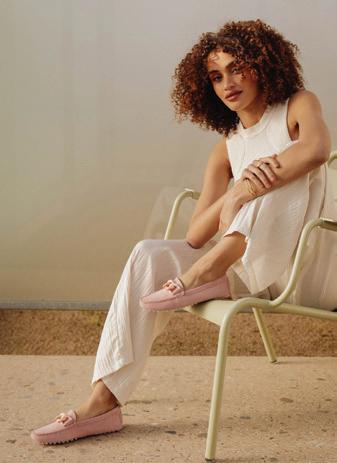
elegant, not overly sophisticated, toned down, natural, discreet,” says Yolsé. Bobbies assistant manager Cindy Leignier adds: “Just a pair of jeans with a blazer and little ballerina flats – and always a nice bag.” I’m taking notes.
Across the road at Claudie Pierlot, shoppers are greeted by a whole wall of ballerinas, as well as immaculate cropped jackets and tailored trousers in a classically Gallic palette of navy and cream. Assistant store manager Luna Diez explains that androgyny and nonchalance are crucial parts of the French girl formula. “They keep it simple, they look put-together but without putting too much effort in.
And always a touch of masculinity – a blazer, even if you’re wearing a skirt.”
Proportions are key too, for the look fashion editors love to call ‘boyfriend-borrowed’ (let’s ignore the fact my husband’s hips are narrower than mine have ever been). “French girls wear things quite oversized. Even jeans, you always want them a little loose,” says Luna. “Blouses with some volume to them, so you have the air on your clothes – nothing skintight. The hair is a bit messy, not perfectly done, but at the same time still aesthetic. Everything is a choice.”
So: carefree but curated. Effortless but put-together. Not

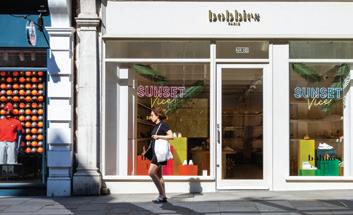
24 — MARYLEBONE JOURNAL / ISSUE NO. 105
LE STREET, C’EST CHIC
Left: Britt loafers, Bobbies
Right: Selena sandles, Bobbies
Far right: Bobbies x Juny Breeze
Virna mules, Bobbies

“We recycle seriously. We value craftsmanship, anything artisanal. And there’s a big tradition of thrift shopping and flea markets in Paris.”
Yolsé Bandaogo, store manager, Bobbies Marylebone
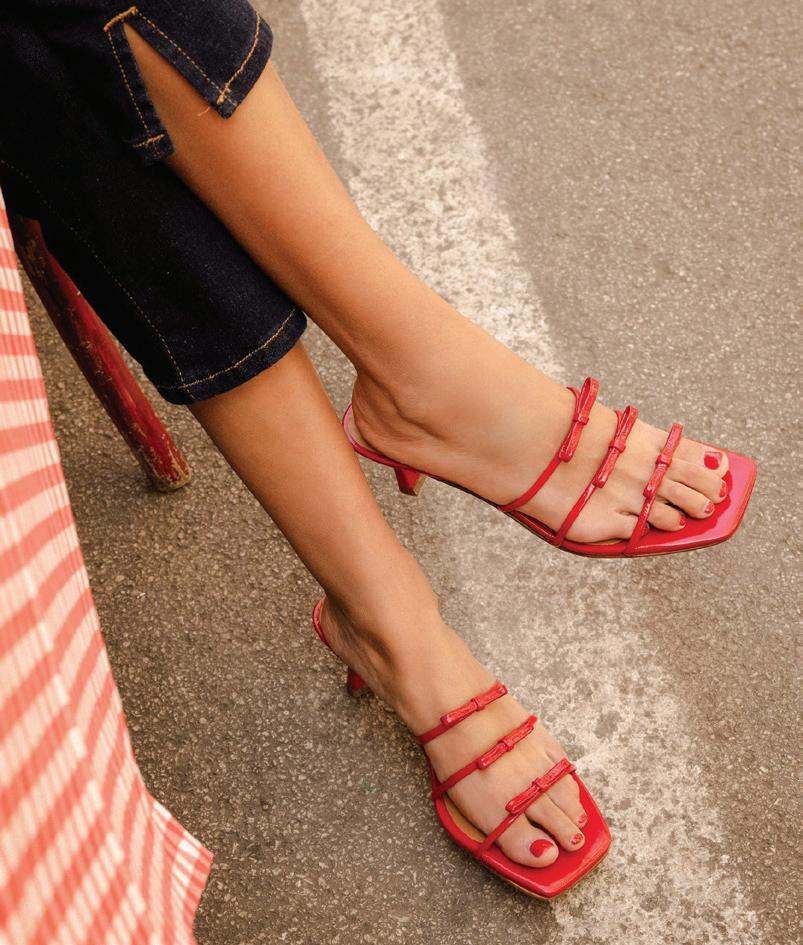
afraid to be a bit of a scruffbag… as long as there’s an expensive bag or Hermès scarf to balance things out. It sounds simple, but as any foreigner who has ever tried to mimic the formula can attest, it takes more than a few Bretons in your wardrobe to really earn your stripes. Still, there’s hope when we remember that some of the most famous of the French girl genre – Jane Birkin, Audrey Hepburn, Marie Antionette –weren’t actually French at all.
One Brit who has managed assimilation is Marissa Cox,
author of Practising Parisienne: Lifestyle Secrets from the City of Lights, who moved to Paris 11 years ago and now shares her fashion and lifestyle flair via her newsletter, Rue Rodier.
“I do think there is still a certain DNA – a ‘classic’ and understated style with a wardrobe made up of timeless, elevated essentials in muted colours,” she says. “Most Parisians will indeed have these pieces in their wardrobe, but it’s becoming more and more difficult to pigeonhole Parisian style as any one aesthetic, and also a little outdated to do so.”
More colours and prints are creeping in these days, she says, and a little less conformity too.
“I think it certainly has something to do with living in a post-pandemic world and wanting to have more fun with what we wear.” This is in evidence at Sandro, where rhinestoned shirts and crochet trousers share the rails with bouclé jackets and preppy knitwear –and at Ba&sh, where you can buy a mutant mash-up of a trench coat and denim jacket.
But if there’s a cheat code for contemporary Parisian chic, you’ll probably find it a few doors up at Sézane. There’s the
25 — MARYLEBONE JOURNAL / ISSUE NO. 105 > LE STREET, C’EST CHIC

same foundation of impeccably cut denim, shirts and premium knitwear, but this time with a distinctly retro vibe – earth tones, suede, kick flares and bias-cut hemlines abound. Which isn’t surprising, as Morgane Sézalory began her career selling vintage online, before launching Sézane as a digital-first brand in 2013.
Old-fashioned bricks and mortar is now a key part of the label’s offering, with its flagship store – known as an ‘appartement’ in the brand’s parlance – kitted out like a classic atelier, with polished wooden counters, plush seating and an abundance of chic staff to
fetch, fold and proffer opinions. In a world of faceless, AI-generated, ultra-fast fashion, it’s not hard to see the appeal of a return to a more tactile boutique experience.
In fact, that willingness to put the hours in and shop in person could be part of the Parisian woman’s secret. “Despite an air of nonchalance and effortlessness, they do make an effort,” says Marissa. “Not in an obvious way, like lots of makeup and accessories – more like a well-cut pair of jeans, a good watch or bag, a good quality jacket that they can wear again and again. They invest in quality. Fast fashion and fleeting trends are less
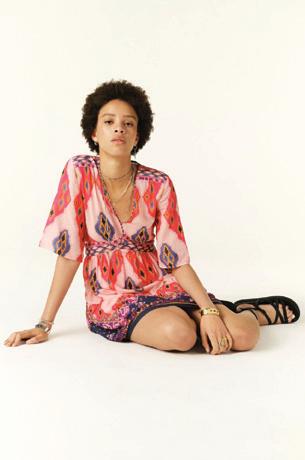
likely to find their way into their wardrobes.”
Which is not to say Marylebone’s French brands are all complete strangers to a micro trend or polyblend. Among the organic denim and 100 per cent linen there are still synthetics and sequins. But back home, France is taking a firm stance on fashion’s environmental crimes. A slew of new legislation aims to clean up the industry, including penalties for climate offenders, a ban on fast-fashion advertising and rules that make brands take responsibility for textile waste, repair and recycling.
26 — MARYLEBONE JOURNAL / ISSUE NO. 105 LE STREET, C’EST CHIC
Left: Cobby shirt, Ba&sh Below: Yaya dress, Ba&sh
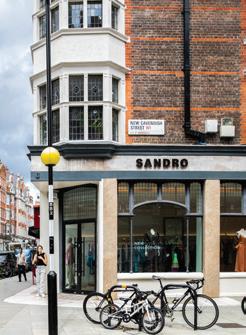
PETITE FRANCE
French womenswear in Marylebone Village

agnès b 40-41 Marylebone High Street, W1G 6PS agnesb.co.uk
Ba&sh
9 Marylebone High Street, W1U 4NW ba-sh.com
Bobbies
102 Marylebone High Street, W1U 4RN bobbies.com
Claudie Pierlot
14 Marylebone High Street, W1U 4NS uk.claudiepierlot.com
Gerard Darel
21 Marylebone High Street, W1U 4PE gerarddarel.com
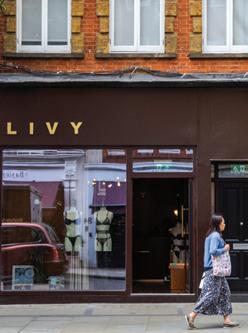
Jott
103 Marylebone High Street, W1U 4RP justoverthetop.co.uk
Livy
85 Marylebone High Street, W1U 4QS int.li-vy.com
Maje
30 Marylebone High Street, W1U 4PN uk.maje.com
Sandro
6 Marylebone High Street, W1U 4NJ sandro-paris.com
Do French shoppers care more about sustainability? Yolsé Bandaogo at Bobbies thinks so. “That awareness is very present –you can see it in the commercials on TV, in every home. We recycle seriously. We value craftsmanship, anything artisanal. And there’s a big tradition of thrift shopping and flea markets in Paris.” Nearly 50 per cent of online shoppers in France report buying refurbished or secondhand items online. “There’s value that we give to old things, with a certain patina,” says Yolsé. “People prefer that to something brand new from the store.”
When it comes to making new
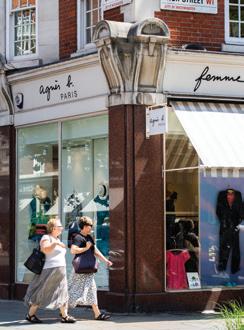
Sessùn
36 Marylebone High Street, W1U 4QD sessun.co.uk
Sézane
28-29 Marylebone High Street, W1U 4PL sezane.com
The Kooples 110 Marylebone High Street, London W1U 4RY thekooples.com
shoes, Bobbies strives to tread gently. “It’s completely embedded in the company’s way of thinking. All the rubber we use is recycled, we completely avoid using plastic, our boxes come from certified forests, and we work with small, family-owned workshops in Portugal that have been operating for a long time. We also have our own repair shops, and we try to encourage people to repair more than replace.”
On the swing tags at Sessùn, Maje, agnés b, Sandro and more you’ll find a QR code that reveals each garment’s fabric composition, recyclability and traceability scores.
27 — MARYLEBONE JOURNAL / ISSUE NO. 105 LE STREET, C’EST CHIC
>
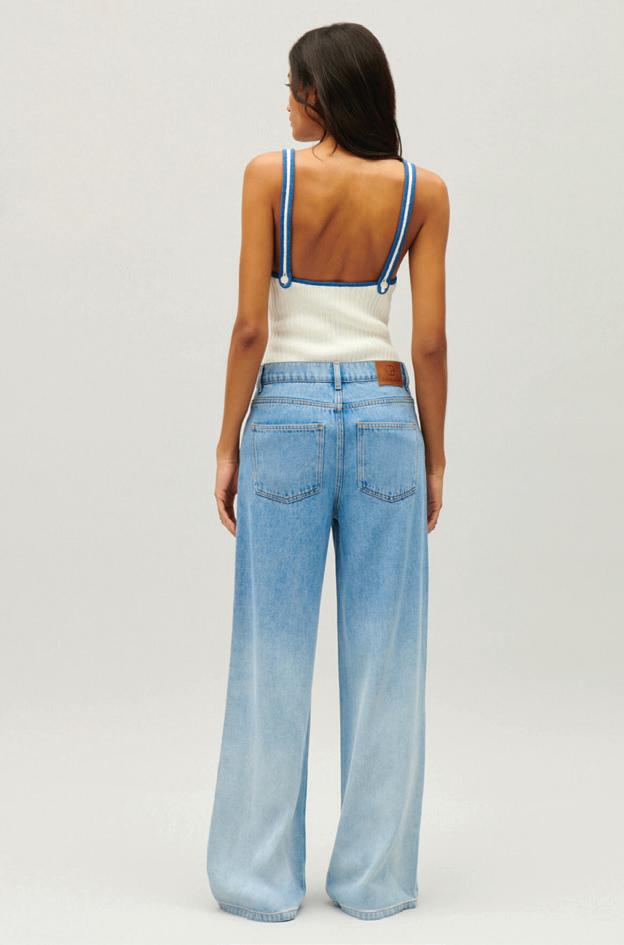
It’s an initiative powered by another French export, Fairly Made, which was founded in 2018 with a mission to help brands untangle their notoriously knotty supply chains and make it easier for shoppers to find out where their clothes are made, and how. Meanwhile Sézane was one of the first fashion brands to become a B Corp, the ethical certification awarded to businesses making a positive impact across five key areas: governance, workers, community, environment and customers.
“We’re surrounded by noise and pressure to do things a certain way, yet Sézane has always been a means through which we could

“French girls wear things quite oversized. Even jeans, you always want them a little loose.
Blouses with some
volume to them, nothing skintight. The hair is a bit messy, not perfectly done. Everything is a choice.”
Luna Diez, assistant store manager, Claudie Pierlot
celebrate ‘la liberté Française’. Create, undo, challenge and improve,” says Morgane Sézalory.
Perhaps it’s ironic, that a country so devoted to freedom became famous for its uniform dressing.
But while the UK’s fascination with French fashion is going nowhere any time soon, it seems the feeling could be mutual. “It’s funny, British people revere French style, but French people love the way that British people express themselves with their clothing,” says Yolsé.
“You’re more daring, there’s less conformity. We say ‘the typical
French or Parisian girl’ and we have an idea of what she looks like, but there’s no ‘typical’ British or London girl.”
It’s true – if Parisians are famed for their sartorial restraint, then Londoners are the opposite: a riotous mishmash of historical and geographical references, subcultures and style tribes. We’re Victorian milkmaids one day, Y2k ravers the next.
But for now, in the corner of W1, we’re still chasing the legend of effortless chic. And if looking good in the rain is one of the criteria, at least we get plenty of practise.
28 — MARYLEBONE JOURNAL / ISSUE NO. 105
LE STREET, C’EST CHIC
Michel baggy jeans, Claudie Pierlot Right: Belted jumpsuit, Claudie Pierlot
MARYLEBONE PSYCHOTHERAPY
17 Nottingham Street, London, WtU 5EW
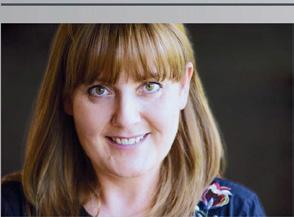

Magda Harbour
0796 8114196
Magda is recognised as one of London's leading experts in hypnotherapy. She specialises in using hypnotherapy to resolve stress, trauma, anxiety, sleep and eating disorders, as well as chronic or non-specific pain. Magda's compassionate approach and extensive experience enable her to create personalised solutions for her clients, helping them navigate challenges and achieve lasting wellness. Beyond her clinical expertise, Magda is recognised for her unwavering dedication to the wellbeing of her clients.
Christian Morton
My world class practice offers a breadth of psychotherapy services for individuals, couples, families and groups. We help clients address their concerns and take a depth-focused approach to therapy. The ultimate goal is to help clients gain insight into both past and present experiences in order to empower themselves to make informed choices that lead to meaningful change. Our business insights program is highly successful amongst prominent business leaders in Central London area, this partnership stimulates both growth and improved performance support without stigma.

include: Emotionally Focused Therapist (Certified) Internal Family Systems AEDP ISTDP EMDR Psychodynamic www.MilesPulver.com miles@milesQulver.com

BSc (Hon) Psychology, LAPHP, MNRPC, BPS Integrative Therapy CBT Hypnotherapy I Psychotherapy Psychosexual Therapist Couples Counselling Business Coaching www.inthemen.com christian@inthemen.com
Miles Pulver 0781 091112
The stuff of life: Live, Love, Work Live: With deep experience and extensive training in modern psychotherapy approaches, I accompany you through life's challenges, helping and guiding you to resolve emotional distress, trauma and
relationship difficulties. Love: I also empower couples to enhance their connection and intimacy whilst assisting individuals to explore new relationship skills and change counterproductive relationship patterns. Work: Leveraging my prior business background, I offer confidential and collaborative support to business leaders dealing with personal and performance-related issues, as well as providing "Partnership Therapy" to enhance relationship dynamics within businesses.
Luiza Neumayer
0780 337 5794
Transitioning from a background in banking and charity work, as a management trainer and CEO, I've become a chartered psychologist specialising in Jungian psychodynamic counselling and contemporary, neuroscience-informed psychotherapy. My personal experiences of working and understanding trauma have informed my practice. I now offer valuable expertise in addressing attachment trauma, PTSD, anxiety, depression, relationship and a range of other issues for individuals and couples. My approach is described by clients as safe, relational, insightful and transformative, fostering healing and growth. I am also registered with insurance companies and welcome clients to my office in Marylebone.

■
MAPHP, MNRPC Advanced Analytical HypnoPsychotherapy I Clinical Hypnosis and Psychotherapy NLP Cognitive Behavioural Therapy Vagus Nerve Therapy in Trauma Recovery I Psychosexual Therapist info@magdaharbour.com
Resident TV Expert on Mental Health 0780 852 3787
MA (Oxon) - MA (Tavistock Relationships) Approaches,
Chartered Counselling Psychologist Psychodynamic & Experiential Psychotherapist HCPC - BPS - BACP AEDP & ISTDP Certified Therapist EMDR UK Accredited Practitioner Brainspotting Certified Therapist EFT Certified Couples Therapist www.psychologistneumayer.co.uk
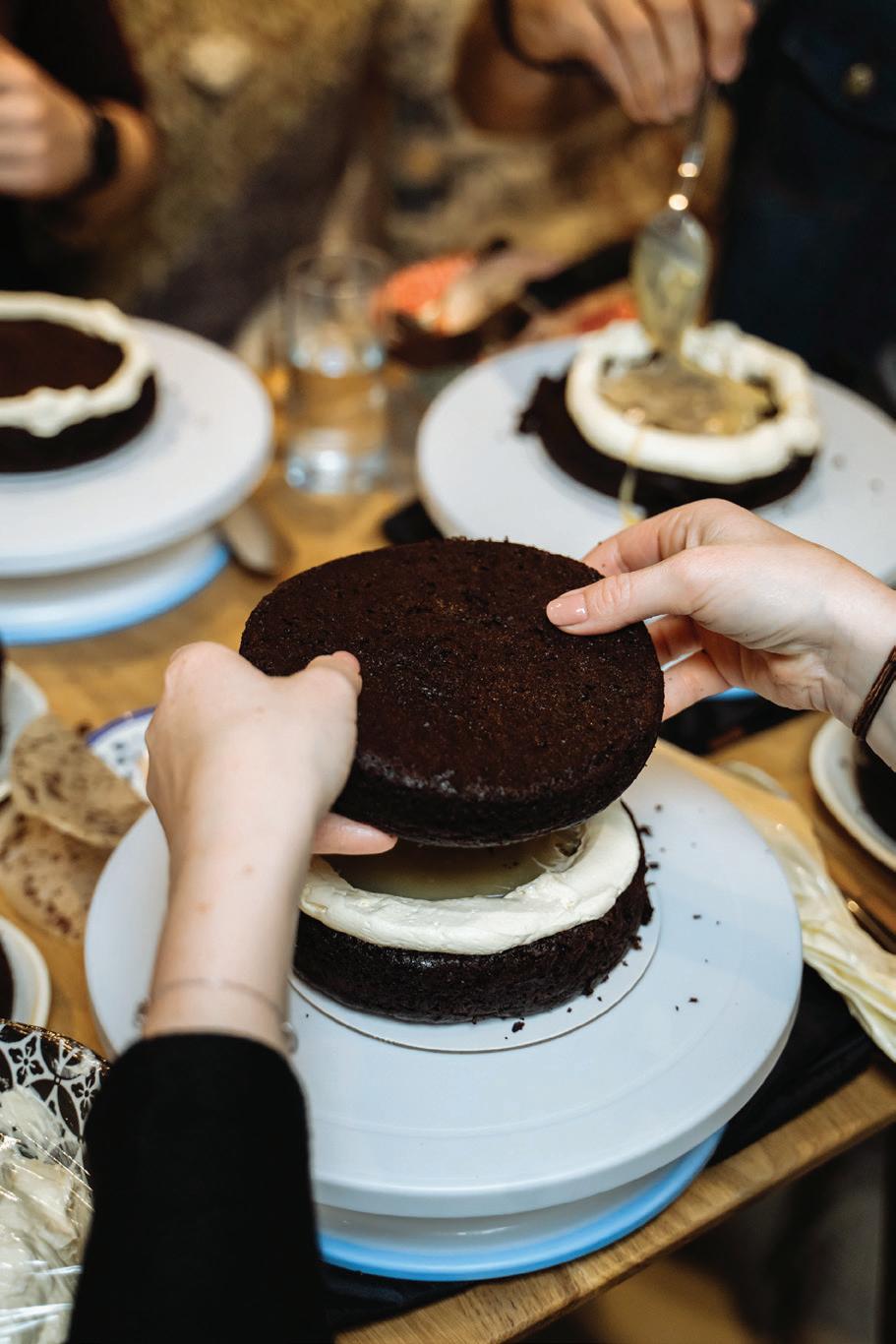
FUN THINGS TO DO IN PORTMAN MARYLEBONE FUN THINGS TO DO IN PORTMAN MARYLEBONE FUN THINGS TO DO IN PORTMAN MARYLEBONE FUN THINGS TO DO IN PORTMAN MARYLEBONE Discover what’s on by scanning the QR code below portmanmarylebone.com @portmanmarylebone BROUGHT TO YOU BY
THE DIFFERENCE MAKERS
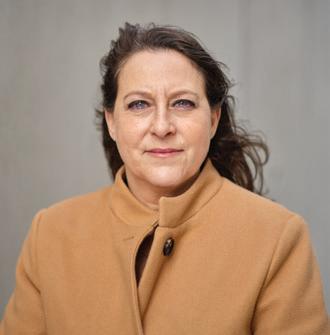
Introducing the people behind central London’s vital charities and community organisations: Louise Griew, CEO of Roald Dahl’s Marvellous Children’s Charity
Interview: Jean-Paul Aubin-Parvu Images: Orlando Gili
Roald Dahl’s Marvellous Children’s Charity provides specialist nurses and other support for seriously ill children across the UK. It was set up in 1991 by Roald Dahl’s widow, Dame Felicity. She and her husband suffered a great deal of personal tragedy with their own children and so were passionate about helping others who are going through similar experiences. Roald Dahl believed in kindness and had a particularly deep respect for nurses.
Our specialist nurses work within the NHS, looking after children who have complex medical conditions, which are often rare or even undiagnosed, and require specialist care from numerous health professionals. There are currently over 150 of these nurses caring for more than 36,000 children, many of whom are unable to walk, talk or feed themselves, and may even face a life-limiting diagnosis.
A complex diagnosis brings overwhelming anxiety and emotional stress to the parents and families, and often an acute sense of isolation. Parents also struggle to juggle work with all the hospital appointments –which could be daily – and many of them are forced to reduce their working hours or potentially give up work completely, which has a significant impact on their finances and only adds to the stress.
The logistics of managing a child’s care, which often involves hospital appointments across multiple specialisms and departments, can be extremely challenging in itself. Then there’s all the different medication to deal with, and all of the potential side effects. Particularly when there are other siblings to think about, it becomes a constant struggle to maintain the normal daily rhythms of family life. With these multiple conditions, the prognosis that goes with them is never very good, so for the parents it’s about trying to be in the present, working out what’s best for their child and their family, without thinking too much about the future.
Our Roald Dahl specialist nurses are simply incredible, and I’m humbled every time I meet one of them. In the way they care for the children and support the families, they go far beyond anything that you could imagine. They provide real holistic care – as well as clinical care, they offer really important emotional and practical support.
31 — MARYLEBONE JOURNAL / ISSUE NO. 105
> THE DIFFERENCE MAKERS

“In Dahl’s books there’s usually a special adult who is lifting the children up, helping them achieve what they need. Our specialist nurses are trying to do the same.”
32 — MARYLEBONE JOURNAL / ISSUE NO. 105
THE DIFFERENCE MAKERS
One of the nurses’ key roles is to coordinate clinical care. The families tend to have appointments coming out of their ears, with a multitude of consultants and other health professionals across various hospitals. Our nurses coordinate that care, so that the children and their families are not in hospital for a single moment more than they need to be, and they will often try to get several appointments fixed for the same visit. There are benefits for hospitals too: by being contactable 24/7 they reduce A&E visits and hospital admissions, because the family is able to phone them with any concerns. Our specialist nurses really become a vital lifeline – they advise, they reassure, and they become a real extension of the family.
These are all senior nurses, and they need to be experienced leaders who are confident at building networks around the hospitals and bringing those networks together to provide the best possible care for the children. We measure their impact in four key areas: improved quality of care; improved experience of care; improved efficiency and cost effectiveness; and improved resilience of seriously ill children and their families.
During Covid we launched our Marvellous Family Support Service, which includes financial, emotional and peer-to-peer support. This is about identifying the benefits that the families may be entitled to, and then either helping them to apply for that funding or supporting their appeals against decisions that have already been made. So far we’ve helped to unlock over £1.5 million worth of benefits. We are also acutely aware of the emotional support that our families need and so are currently piloting an emotional support service. We talk to parents over the phone about their child’s behaviour, sleep and wellbeing, but also about how the parents themselves are coping. We are looking to do even more work on that. With our peer-to-peer support, we bring families together in workshops so that they meet others who are in a similar position, which reduces that overwhelming feeling of isolation. We are also trying to help them by providing training –for example, in paediatric first aid.
These families would really struggle without one of our specialist nurses. In fact, we hear about how much of a struggle it is from those families who don’t have
one. Parents struggle with trying to reach medical experts by phone, getting the right equipment and the right medication, seeing the right people and getting their appointments even vaguely coordinated. They feel isolated. They struggle to manage conflicting medical appointments. They sometimes even struggle to understand what the medical professional is saying to them, particularly when English is not the family’s first language. As a result of their experiences, these parents often have very poor mental health, and we’ve seen evidence to demonstrate that many marriages fall apart under the strain.
There are thousands of children in the UK currently living without the specialist care they so desperately need. We are currently trying to raise £1 million to establish new Roald Dahl specialist nurses around the country, two of whom will be based at London hospitals. And these nurses will be totally focussed on children with these multiple conditions. We are absolutely delighted to have been chosen to become The Portman Estate’s corporate charity partner for the next three years. Their involvement will be huge, and we’re hoping to grow the partnership year on year. As well as engaging their employees in supporting and volunteering, we’re hoping that our work together will help raise awareness of the vital job we do. We can provide members of the public with access to all sorts of fundraising challenges, whether it’s jumping out of a plane, cycling, or running a 10k or marathon, plus all the weird and wonderful events that are out there. The more money we raise, the more specialist nurses we can provide for these seriously ill children.
Roald Dahl loved his wife very much and I think he’d be thrilled that she set up this charity – I’m sure it would touch him immensely. We often say that our children are like the characters in his books – brave like Matilda, resourceful like James, kind like Charlie. In his books, there’s usually also a special adult who is lifting these children up, helping them achieve what they need, whether that’s Miss Honey with Matilda or the BFG with Sophie. Our specialist nurses, who are providing this incredible care and support for these children, are trying to do the same.
ROALD DAHL’S MARVELLOUS CHILDREN’S CHARITY roalddahlcharity.org
33 — MARYLEBONE JOURNAL / ISSUE NO. 105 THE DIFFERENCE MAKERS
A CLOSER LOOK
FOOD » 34
STYLE » 44
HOME » 58
WELLBEING » 60
HEALTHCARE » 62
STYLE »44 Q&A
Charlie Casely-Hayford on continuing his father’s design legacy, dressing Paapa Essiedu, and how the suit is being rebooted
STYLE »46
STYLE PHILOSOPHY
Stacy Chan of Platform on collaborating with designers, telling stories, and choosing to dress mainly in black
HOME »58 ANATOMY OF A DESIGN
Pascale and Francis Gelb of Sabre on a collection that sums up the unique approach of their French cutlery brand
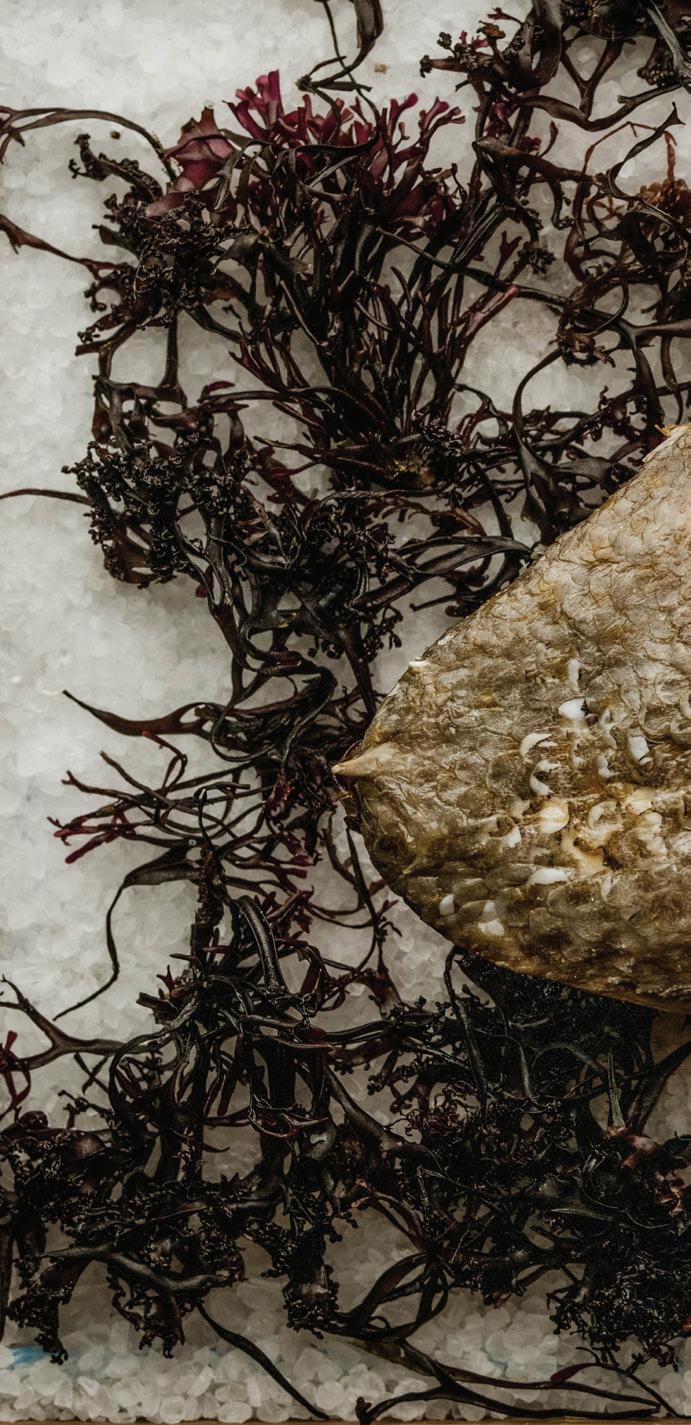
34 — MARYLEBONE JOURNAL / ISSUE NO. 105
A CLOSER LOOK FOOD
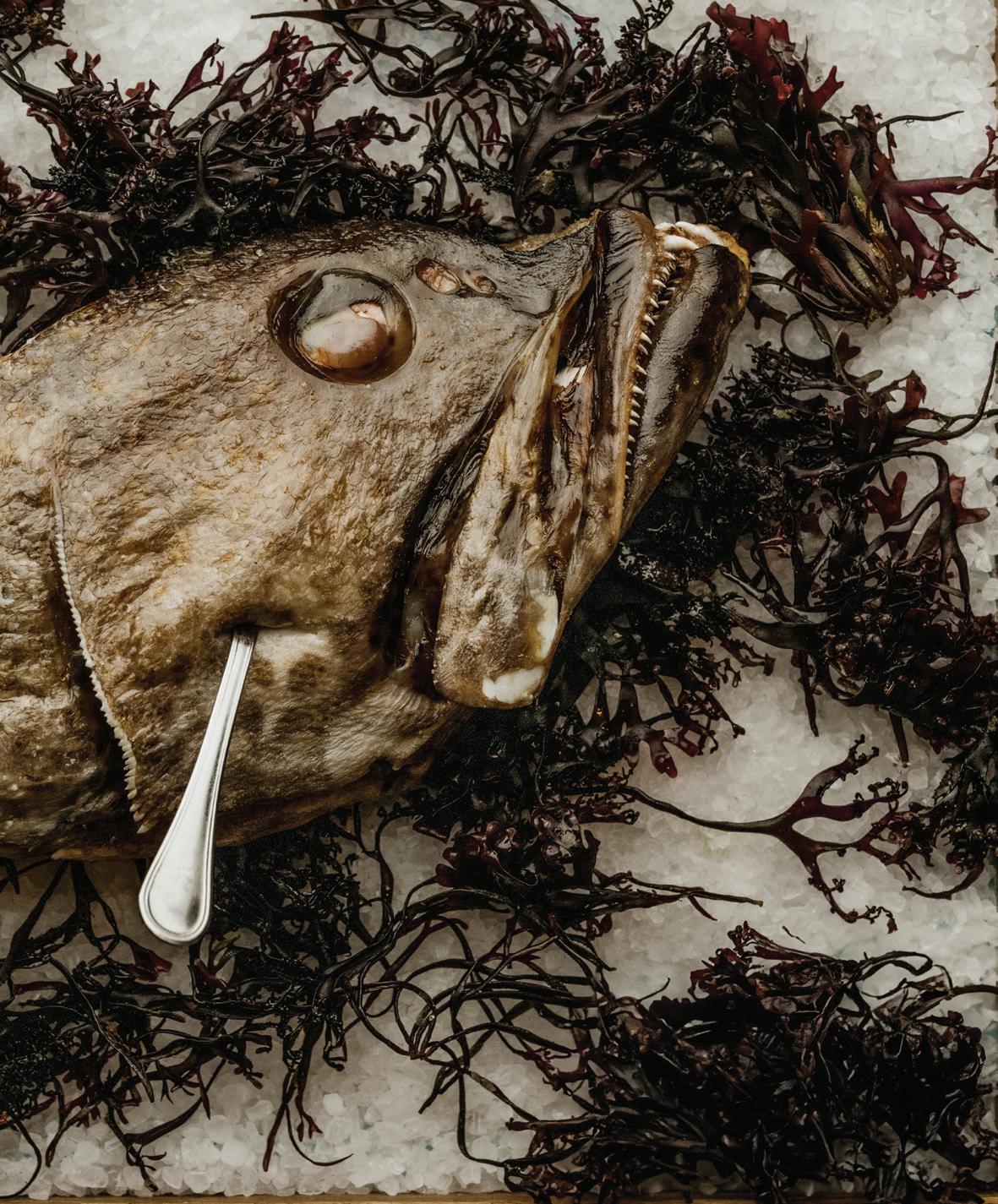
Q&A: NIKOS ROUSSOS
The executive chef and managing director of Kima on the quality of Greek produce, the fin-to-gill concept, and the joys to be found in a fish head
35 — MARYLEBONE JOURNAL / ISSUE NO. 105 A CLOSER LOOK FOOD >
Interview: Clare Finney Images: Steven Joyce
Q: How did growing up in Athens shape your experience of and approach to food?
A: Athens is a very big city – almost four million people – and there’s lots going on. My parents owned a silversmith business – the mirrors and the olive branch macaron holders in our restaurant are made by their business, which they’ve retired from now – and I worked there before retraining as a chef. My parents were born in Athens too, so we were really immersed in the city. However, my grandparents lived outside of Athens, in the countryside, and that is where we
spent our vacations. It’s where we learned about food and how it should be, where we ate amazing free-range eggs and meat and cheeses. We had a good idea of produce and what makes it. We grew up in the big city, but we had the culture of the countryside.
Q: When your first London restaurant, OPSO, opened in Marylebone 10 years ago, Greece’s food scene was undergoing a transformation, thanks to young people returning to the country in the wake of the financial crisis. What is Greece like now, and how
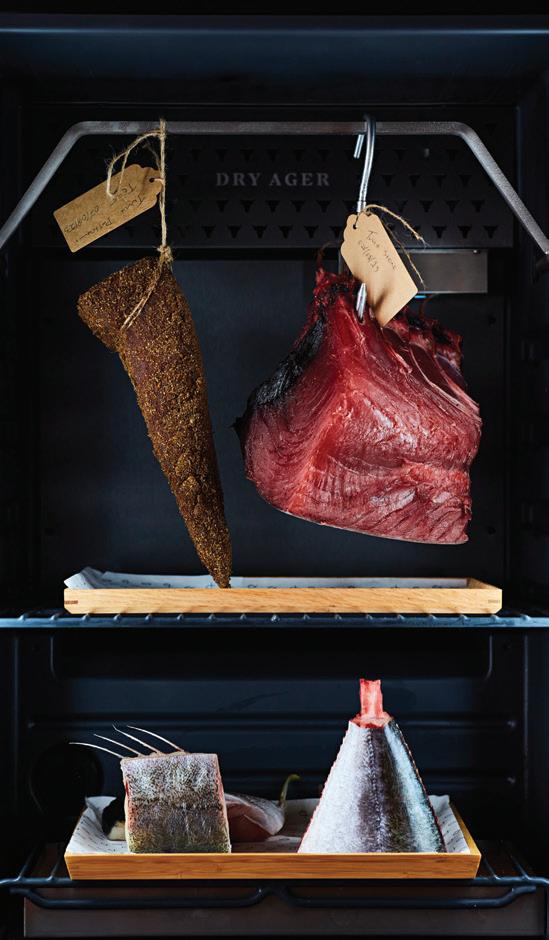
does your new restaurant, Kima, reflect this change?
A: We’ve always had amazing produce, but it’s getting better all the time, as young people work with their elders and revive old recipes and methods. At Kima and OPSO almost everything comes from Greece: the cheese, the bottarga, the vegetables – even the salt comes from a friend of ours who handpicks it off the rocks of one of the Greek islands. We have olive oil rusks from one island, olive oil flatbread from another, and different types of olive oil for different uses. Each year we choose our extra virgin olive oil, from

CHILTERN STREET DELI
Sara Held of Chiltern Street Deli on the New York deli experience, waste reduction, and the importance of community Interview: Viel Richardson
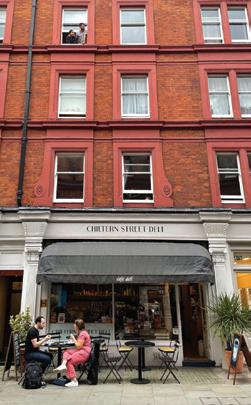
36 — MARYLEBONE JOURNAL / ISSUE NO. 105
A CLOSER LOOK FOOD
FOOD PHILOSOPHY
Left: Fish in Kima’s dry ager
Above: Nikos Roussos
premium producers; this year we use two kinds, both of low acidity. One is from 100 per cent manaki variety, the other is mix 70 per cent manaki and 30 per cent koroneiki. It’s expensive – never more so than now – but we do that math and keep going because it’s important to us. It’s important to our quality. In Athens, the food has changed a lot. As well as the old tavernas and mezze places, you have Spanish, Peruvian – even omakase. It’s Japanese, but the fish is Greek. It’s an international scene, and that is shaping new age Greek chefs, not just in Athens but everywhere in Greece, including the
I really never had that ‘I want to work in hospitality’ moment. I think like a lot of people I just sort of fell into it. I’m from New York and was in London getting my master’s degree at Goldsmiths and needed some extra cash, so replied to an ad from a burger stall in a street food market in Soho. In street food you have to do a bit of everything and I just fell in love with all of it from the start. From there I moved into pubs and eventually started my own business.
People sometimes ask me to define a deli and that can be a tricky question. There are different types of delicatessen: there’s the traditional Italian
countryside. There are more and more Michelin stars, so many good chefs. It’s an amazing culinary hub.
Q: How do you find producers?
A: We’ve been around for many years, in London and in Greece. We used to have a two Michelin star restaurant in Athens, called Funky Gourmet. It was open for 10 years until Covid hit. In London, as well as OPSO and Kima, we have INO in Carnaby Street and a street food stall called PittaBun in Camden market. As a result, we’ve spent years scouting for producers. We still travel around our country every
deli, with bespoke sandwiches, cured meats and cheeses, there’s the Jewish-style deli which has big fat meat sandwiches like corned beef on rye, with Russian dressings and pickles on the table. What I’m trying to achieve here is a ‘bodega’ – it’s the New York version of the deli and it’s what I grew up with.
A New York bodega is like the local shops here in the UK, but with a kitchen where we make food to eat there or take away. It’s where people are going to get their sandwiches, their breakfast on the way to work, or drop in when they want a snack. The key thing is that they develop a real connection
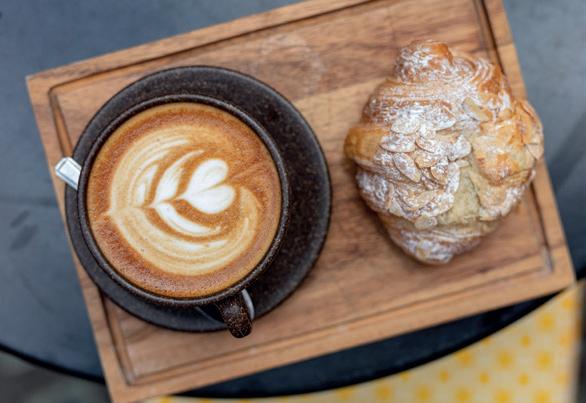
year, seeking out great produce to bring to our restaurants. It’s a vital part of the job.
Q: Kima is bang opposite OPSO. How do the two differ?
A: OPSO is an established restaurant. It is our landmark. Kima is an innovator. We wanted to create a sustainable restaurant with fish at the centre and find many different ways of enjoying the daily catch. The idea is that you choose your fish – depending on the catch and the number of people at the table – and we prepare it in three to five different ways, so you eat as much of >
with the community, and that is what I want to recreate here.
Wherever I look, everyone’s serving the same sandwiches – tuna, chicken, ham, cheese. I wanted to offer the best bits of the bodega. That means turkey sandwiches, Americanstyle bacon, grilled cheese, great bagels – ingredients that represent the best of New York. Turkey is a year-round staple in many parts of America, and it’s something people in New York eat daily, so I wanted that on the menu. Sourcing highquality sustainable turkey was important. I tried samples from several suppliers as well as researching their farms before choosing one.
In some ways, we’re a pretty straightforward space: sandwiches, pastries, salads and coffee. We serve wonderful pastries from Rockstar Bakers, a femaleowned bakery that I love, and great coffee from Dark Arts.
Sustainability is very important here and this is a zero-waste company. Everything is used. Vegetable skins go into stock that is used for the next day’s soup. We also use an app called Too Good to Go – they collect and distribute anything we haven’t sold by the end of the day. There’s very little wastage on our part. We know how many sandwiches
we sell a day, so we aim to make just enough. Witherslack Orchards send their apple juice down in glass bottles and we send them back for reusing. It’s about commitment and making smart choices and working with other businesses that have the same ethos as you.
For me, you cannot separate food from community and that is especially true of a deli. It’s important that we support small and, where possible, local businesses. Our sodas are from Hip Pop, who make really good, sustainable drinks. We sell some unusual products – Strp’d, for example, is a nut-free flour alternative made using tigernut, a root vegetable from Africa. Some of our customers make wonderful products and we’ll sometimes stock them if they struggle to find another outlet.
I’ve never been in a community where everyone has been so incredibly supportive. When I started, I spent a couple of months just speaking to everybody, asking what they wanted, what they thought of how the deli was run before, what could we do to improve it for them. They have been so responsive and that has helped me build what we have.
CHILTERN STREET DELI
27 Chiltern Street, W1U 7PJ chilternstreetdeli.co.uk
37 — MARYLEBONE JOURNAL / ISSUE NO. 105 A CLOSER LOOK FOOD


even Greek. We are really happy about that. We are happy to have established modern Greek food. Think about how many French and Italian restaurants there are – there was room for Greek food to spread, and it has. I think one of the advantages of our cuisines is how well it represents the Mediterranean diet. We are inspired by both Eastern and Western influences. Recently, we hosted many chefs in our restaurant, including Ferran Adrià and Ana Roš, as part of the international Gastromasa Gastronomy Conference taking place this year in London. One of our canapes was a dolma, which traditionally is cooked rice wrapped in a vine leaf. We used a traditional Greek pasta, wrapped in a vine leaf and cooked over charcoal, then topped with Greek caviar. They loved it. Modern Greek food is more than a trend now; it is here to stay.
it as possible. At lunch, we propose smaller fish so people can come in and eat ‘fin to gill’ even on a quick lunch break. It’s fast and light.
Q: Take us through how you might serve a whole fish, fin to gill.
A: We like to make at least two raw preparations. The fillets are separated from the body, and half of a fillet we dice, and lightly marinate with extra virgin olive oil and lemon. It’s a simple dish, but it’s hard to find the right olive oil for that purpose. We might serve that on a light broth made with fish bones simmered with vegetables and herbs. The other half of this fillet we thinly slice and serve as a carpaccio with hand-harvested sea salt and another type of olive oil. Then we grill the collars and serve those with a Greek salad alongside, and some sourdough bread for dipping. The final fillet we might cook on the grill and serve with smoked tomato orzo or seasonal greens. At the moment, we’re using a lot of spring greens. We also have charred broccoli and smoked potato puree. Part of the tail that holds a generous piece of the juicy flesh might be
smoked, grilled and presented like a fish ‘shank’. We have a lot of regulars, so we’re always finding new ways of enjoying the fish – and of course, the fish changes too, with the season.
Q: Is eating fish in this way common in Greece?
A: Yes, it is common to eat the whole fish; to eat the cheek, eyes, head – even the spines, in the case of smaller fish, as when you fry them, they become crispy. There are many places where, if the chef is your friend, you might ask him to have half your fish raw and half on the grill, for example. But there is only one restaurant in Greece that operates like Kima, where having the fish prepared different ways is the philosophy of the restaurant. The owner is a good friend of mine.
Q: How have Londoners’ perceptions of Greek food changed since 2014?
When OPSO first started we were very lonely. We were one of the only places serving Greek wines, for example. Now they are everywhere, at least one or two, on wine lists in restaurants that aren’t
Q: How has the Marylebone food scene changed in the same period?
A: This is a great neighbourhood, and it’s getting better all the time. There has always been a distinct vibe here; that’s why we chose it. I’m not sure it’s changing – I think it’s elevating. It’s becoming more interesting, and higher in quality. We like to think we are adding one more asset to the neighbourhood, where people who love fish can eat something fresh and light.
Q: How should one go about eating a fish head?
A: It depends on the size of the fish! I love the cheeks – they are my favourite – and I love the skin on top of them. The next best thing is the collars, which are really tasty. Once you’ve eaten those you’re good –you’ve done the basics, though you can eat the eyeballs too!
KIMA
57 Paddington Street, W1U 4JA kimarestaurant.com
OPSO
10 Paddington Street, W1U 5QL opso.co.uk
38 — MARYLEBONE JOURNAL / ISSUE NO. 105
A CLOSER LOOK FOOD
Above left: Grouper chops Above right: Fish collar
THE BEAUTIFUL SOUTH
As Trishna prepares for a summer series devoted to the food and culture of Kerala, executive chef Sajeev Nair introduces the distinctive cuisine of his home state
Words: Mark Riddaway Images: Marcus Cobden
When Britain first fell in love with Indian restaurants, the food they served had very little to do with India. The original 20th century wave of curry houses, with their flock wallpaper and sugary kormas, were often owned by Bangladeshis or Pakistanis, and their menus were shaped to suit the reluctant British palate, with its taste for gentle spicing and thick gravy. The result was a new hybrid, Indian in name only.
“People in England didn’t used to be as daring as they are now,” says Sajeev Nair, executive chef at Trishna, Marylebone’s much-loved Michelin-starred Indian restaurant. “Nowadays, we don’t tone down the spice. In fact, the owners here get angry if it’s not spicy enough! We’re doing real, actual Indian cuisine.” And really, that means Indian cuisines , plural. “In India, every 100km you travel, the language changes, the accent changes and the food changes,” says Sajeev. “You can’t really have an Indian restaurant that covers

the whole of India. It’s impossible.”
So, Trishna doesn’t try. Since it opened in 2008, the restaurant has devoted itself to the food of India’s southern coast: Goa, Karnataka, Kerala. This July and August, the focus is tightening still further, with a summer-long celebration of the food and culture of Kerala, Sajeev’s home state. The Kerala Summer programme will include a new lunchtime and early-evening menu devoted to the region, drinks developed in partnership with Tanqueray Nº Ten to celebrate the flavours of Kerala, plus workshops, masterclasses and installations with the same geographic themes.
Stretched along the southwest seaboard, with the Arabian sea on one side and the mountains of the Western Ghats on the other, Kerala is, says Sajeev, “like a narrow belt. But it has everything there: sea, mountains, hills, forests, cities.”
One thing it has in great abundance is
spice. Since ancient times, Kerala has been famed as a source of exceptional and abundant black pepper – a hugely valuable resource that made it a magnet for both trade and invasion. “At Trishna, we get a lot of our spices from Kerala. We get cardamom from the Idukki hills – it’s the most famous cardamom in the world –and we get Keralan black pepper too.”
Sajeev talks with great affection of the feasts served up each year at the Keralan festival of Onam – dozens of dishes, most of them vegetable-based, laid out in small piles on a vast green banana leaf. “In fact, whenever there is an occasion, we do this,” he says. “When I got married, we had the same feast.” He also tells of the stunning Keralan breakfasts, renowned throughout India: “It’s a lot of dosas, appam and stews. Something called idiyappam, which is steamed hoppers. The fish pollichathu –whole fish grilled in a banana leaf – is very famous too.”
40 — MARYLEBONE JOURNAL / ISSUE NO. 105 A CLOSER LOOK FOOD
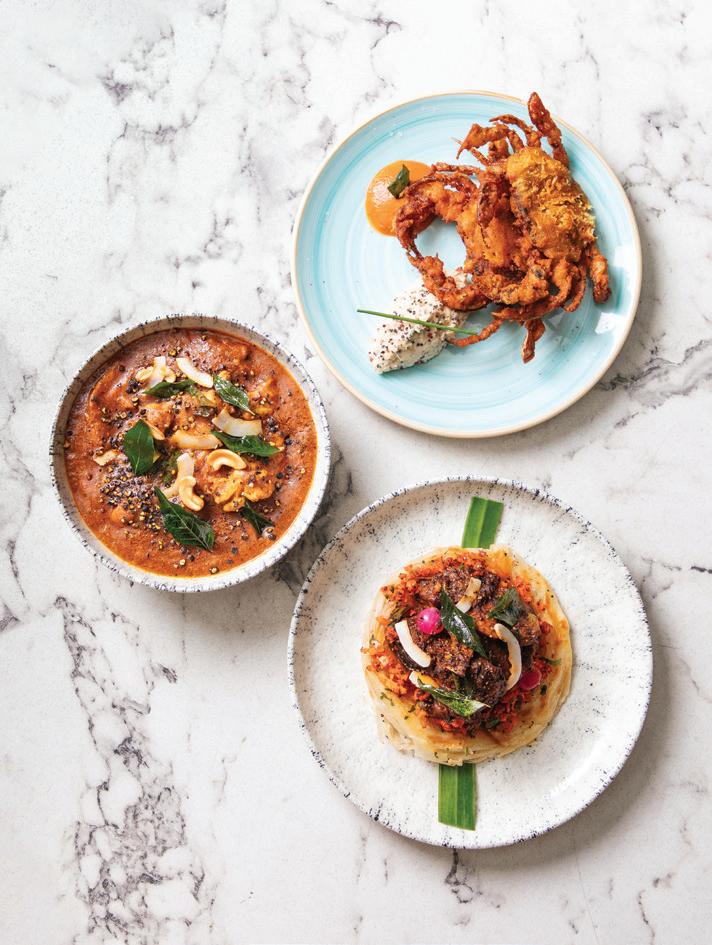
“In India, every 100km you travel, the language changes, the accent changes and the food changes. You can’t really have an Indian restaurant that covers the whole of India. It’s impossible.”
Like most of India, the cuisine includes an abundance of vegetable dishes. The same is true of seafood from the 600km coastline. “We eat a lot of prawns, oysters, mussels, fish,” says Sajeev. But meat, too, plays a significant role. One notable characteristic of Kerala – a result of all those traders and invaders – is the religious and cultural diversity of its people. Most Keralans are Hindu, but the state also has unusually large and deep-rooted Muslim and Christian populations, which adds to the breadth of the cuisine. “India is basically a chicken and fish-eating country, but Kerala is one of only three states where people eat beef. There are lots of Keralan beef dishes, such as the Malabar porotta & beef fry on our menu,” says Sajeev. “There are also lots of Christians there who eat pork – in fact, everything is eaten!”
“Everything” extends to game, particularly in toddy shops, the state’s lively drinking establishments where locals
imbibe palm wine and vibrantly spicy snacks. “We have this toddy shop cuisine where you’ll get wild animals like rabbit, frog, deer, duck, which isn’t something you’ll find in other parts of India. People go there to drink, but they also have family gettogethers – it’s like pub culture in England.”
It’s in England that Sajeev has mastered his craft as a chef. He was born in Kerala, but when he was 10 his family moved to Delhi, around 3,000km to the north. It was there, in India’s capital, that he completed a hotel management course and began working in kitchens. At the age of 22, after just three years as a chef, he made the jump to London. “I wanted to explore more, I wanted to move out of India, and London was always the first choice – it’s English speaking, it’s multicultural, it’s exciting.”
His first impressions? “It was very cold.”
In 2012, Sajeev arrived at Trishna, then still in the early flushes of its success. After starting as sous chef, he was promoted to head chef after less than a year when founder Karam Sethi left the kitchen and set about transforming the London dining scene through his family’s JKS Restaurant Group. Under Sajeev’s stewardship Trishna has retained its stellar reputation – and its Michelin star. The secret? “Consistency,” he says. “Consistency of suppliers, of cooking methods, of staff. Staff are integral. Most of ours have been here eight to 10 years, so it’s a stable team. There aren’t hits and misses. We make sure that every single plate is of the same standard.”
Despite being away for so long, he still feels Keralan through and through.
“I’m 100 per cent Keralan,” Sajeev insists. “It’s an integral part of who I am.” This summer, he’ll give us a taste of exactly what that means.
TRISHNA
15-17 Blandford Street, W1U 3DG trishnalondon.com
41 — MARYLEBONE JOURNAL / ISSUE NO. 105 A CLOSER LOOK FOOD
UNTIL 31 AUGUST KERALA SUMMER trishnalondon.com
Left, clockwise from top: Nandu varuval, Malabar porotta & beef fry, cashew & pepper chicken Opposite: Sajeev Nair
A GLASS APART
Matthias Ingelmann, group bar manager at KOL, on a mezcal that is changing minds and winning new fans for a misunderstood spirit
Interview: Viel Richardson
no idea mezcal could taste like this. It opened my eyes to how diverse the world of agave spirits really is.
As well as the different varieties of agave plant, there are different methods of production. In San Luis Potosi, the mezcal is not usually cooked underground – the process most people are familiar with – but in clay ovens. First, they build a fire to get the oven really hot. When it reaches the right temperature, they pull out the heat source and put in the agave. It’s more like a steaming process and is controlled by a highly skilled mezcalero. Diablo is not barrel aged, so it showcases the pure flavour of the agave and the skill of the mezcalero.
ANATOMY OF A DISH
SLOW-COOKED
PORK LOIN WITH CHARGRILLED SHALLOTS, SPINACH & VEAL JUS
Laura de Filippis, the new head chef at The Cavendish Pub, on a spectacular zero-waste dish
Interview: Clare Finney
Diablo is a very special mezcal. Made in the state of San Luis Potosi in northern Mexico and based on the salmiana variety of agave, which takes about seven years to mature, it completely defies most people’s expectations. The popular idea of mezcal is a full-bodied, rich and smoky drink. I was really blown away when I first tried Diablo – it was rich and punchy but it also had delicate floral and grassy notes with a peppery spiciness there as well. I had
I always say that if you like spirits, there’s a mezcal for you because there are so many different flavour profiles. We have a mezcal flight which is usually three or four mezcals and we always start with Diablo. We do that because it’s light but also because its unexpected flavour profile opens the mind of the customer, allowing them to really appreciate the rest of the experience.
When I first tasted Diablo I could instantly see how well it could work in cocktails. One we serve is a wonderful martini. Usually, I’m not the biggest fan of mezcal martinis because I think the smokiness can make them unbalanced. But this one works incredibly well because of the green notes.
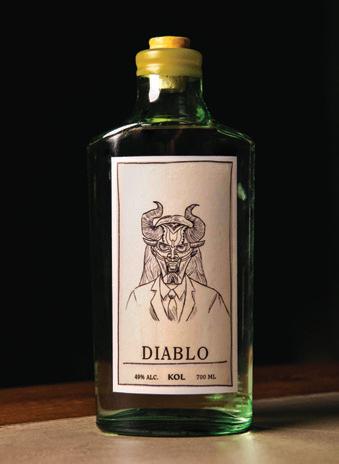
The salmiana agave is a very distinctive and beautiful part of the landscape, growing up to three-metres tall. Something important to us is that they are grown in a very sustainable manner, ensuring that the mezcaleros are able to make this great mezcal for generations to come.
KOL 9 Seymour Street, W1H 7BA kolrestaurant.com
In a nutshell
Our slow cooked-pork loin comes with spinach that’s been pan-fried with confit garlic oil, plus a chargrilled shallot cream made from baby shallots which we confit in lamb fat then grill. The result is a shallot that’s slightly burnt, but very soft because it’s been cooked in the fat. The dish is served with veal jus, which is umami and salty –more of a gravy flavour than a sweet flavour, which balances out the fattiness of the pork.
The inspiration
I was looking for a dish that would represent the transition from winter to summer. You have the warmth of the veal sauce, which is reminiscent of winter, then the freshness and greenness of the spinach, which evokes summer. It’s the perfect in-between dish.
The purpose
I think this dish fits in perfectly with the sort of food I like to cook, which is a combination of the flavours that remind me of my home in Naples, and those which I’ve experienced and worked with during my career. I was also aiming for a zero-waste dish: many of these ingredients come from the remnants of other dishes. The lamb fat used to confit
the shallots comes from the flank used in another dish. The caramelised shallot cream uses scraps from the mignonette that we serve with our oysters. The garlic oil that goes with the spinach is left over from our house-made aioli. We confit the garlic cloves, use those in the aioli, then use the oil to season the spinach. The garnish is a green oil made from the stalks of all the herbs we use in the kitchen, which would normally be thrown away.
The technique
The pork is sous vide at 53C for four hours, then seared to perfection so the outside is crisp and the middle slightly pink. The veal jus is cooked for four days, so it’s reduced to the limit. It’s very intense. The green oil is made by blanching stalks with olive oil, then filtering it a couple of times through coffee filter paper. It takes a day to filter through.
The secret
To me, the real secret is that you would not expect a dish like this to be made from things that would otherwise go to waste.
THE CAVENDISH PUB
35 New Cavendish Street, W1G 9TR
35 newcavendish.co.uk
42 — MARYLEBONE JOURNAL / ISSUE NO. 105 A CLOSER LOOK FOOD
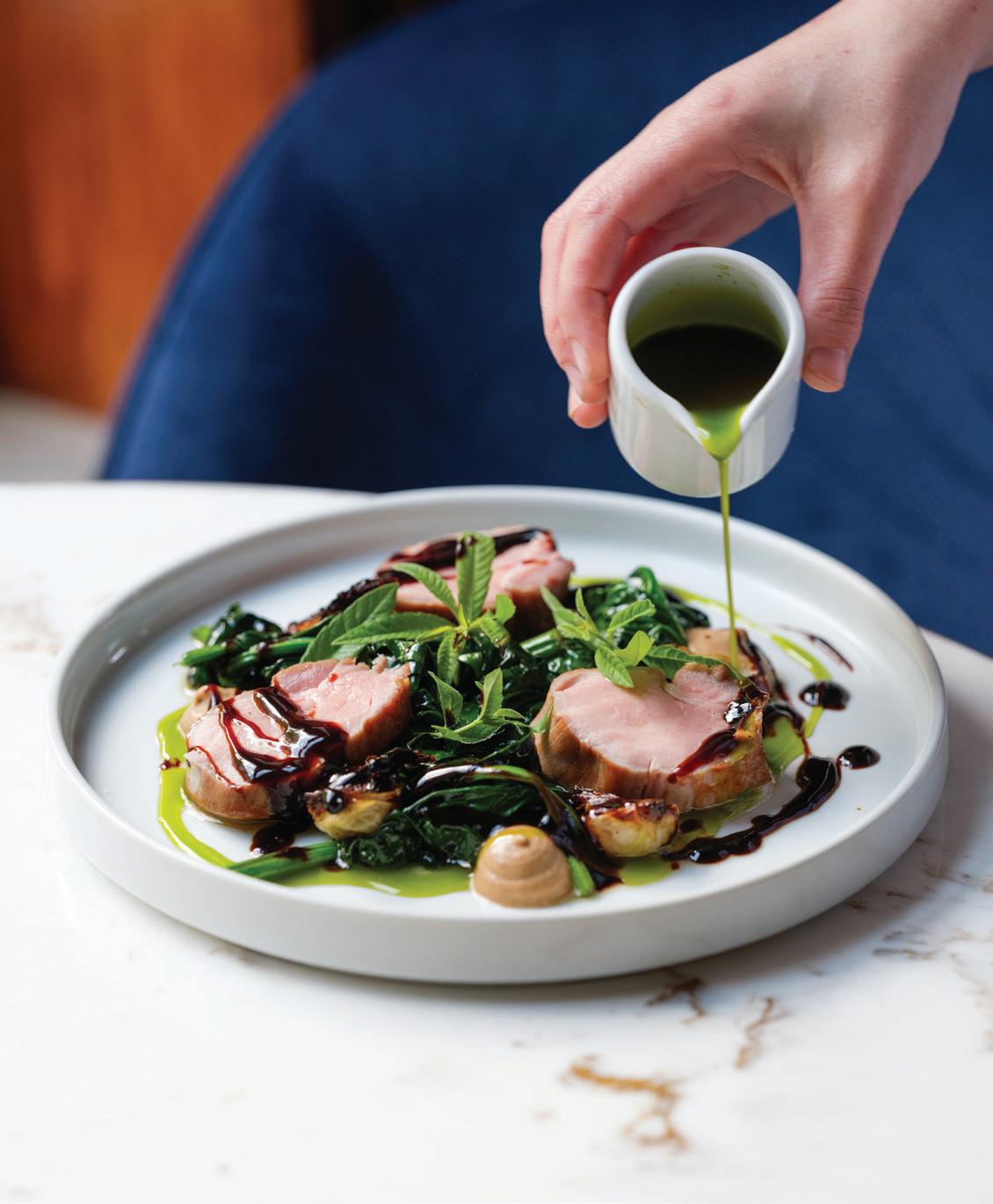
43 — MARYLEBONE JOURNAL / ISSUE NO. 105 A CLOSER LOOK FOOD
Q&A: CHARLIE CASELYHAYFORD
The co-founder of the Chiltern Street atelier on continuing his father’s design legacy, dressing Paapa Essiedu, and how the suit is being rebooted
Q: Casely-Hayford is a family business, and you come from a pretty incredible family – the son of pioneering designer Joe Casely-Hayford. What was it like growing up in such a creative household?
A: My dad met my mum, Maria, at Central Saint Martins when they were 19, and they worked together until he passed away in 2019. My sister and I spent a lot of time in their studios as kids, surrounded by clothes, going to runway shows – it was a pretty insane childhood, but to us it was normality. One time Princess Diana turned up to my dad’s London Fashion Week show, and my sister and I got bumped from the front row to the second. That was an eye-opener.
Q: Last year was a big one for your family, with your father’s work celebrated in The Missing Thread exhibition at Somerset House and commemorated with a posthumous Special Recognition Award from the British Fashion Council after he passed away in 2019. How does it feel to be continuing his legacy?
A: Standing in front of that many people at the Royal Albert Hall was

44 — MARYLEBONE JOURNAL / ISSUE NO. 105 A CLOSER LOOK STYLE
Interview: Lauren Bravo
Portrait: Marsy Hild

45 — MARYLEBONE JOURNAL / ISSUE NO. 105 A CLOSER LOOK STYLE >
pretty nerve-wracking, but picking up the award on his behalf was a real life-making moment. It’s been a really lovely process for me, and a way to connect with a lot of the ideas my dad built his business around. We are a family business first and foremost, and I still work with my mum every day. She was integral in putting together our contribution to The Missing Thread exhibition, a retrospective of my dad’s work since the mid80s, featuring a lot of pieces that haven’t seen the light of day in several decades. I feel more like a torchbearer, carrying on this family legacy to the next generation. It’s certainly not a lonely journey.
Q: You were only 22 when you and he created the Casely-Hayford label together. How did your styles influence each other?
A: There’s always the assumption that I brought the youthful element to the table, but actually it was the other way round! I was more classic, and my dad was always the one pushing the boundaries. He was incredibly engaged with culture, always willing to learn and unlearn. The brand is about duality; it’s a concept that has resonated with my family for generations. My greatgrandfather [eminent lawyer and journalist JE Casely Hayford] would wear traditional kente cloth when he studied at Cambridge, then he would go back to Ghana and wear Savile Row suits. That idea of double consciousness runs through our brand, and also through our family history.
Q: Your family has founded a new scholarship with the BFC to support Black or mixed-heritage design students, and you’ve also become a mentor for the Paul Smith Foundation. What do you hope it will do for the designers of tomorrow?
A: There are a lot of gaps in the industry. So much untapped potential, particularly in this
country; so many people and brands that are not being given the opportunity to do the amazing things I know they’re capable of. It’s very hard for people to break through the cracks unless you know certain people, or you’ve gone to the right college – it’s an elitist industry and there are so many barriers to entry. I’m very privileged in that my path was built for me by my parents, so I’ve had it pretty easy. But I’d like to do what I can to help in levelling the playing field and opening a few doors that have been shut for some time.
Q: Sustainability is another crucial conversation in fashion just now. In the age of ultra-fast fashion, how do we slam on the brakes?
A: It’s such a complicated subject, because there’s no blanket answer. There’s a lot of waste in terms of excess stock, both on the high street and at a luxury level. You’re second-guessing your customer and committing to these huge orders, and then there are piles and piles of clothes at the end of each season and everything is on sale all the time. It’s the antithesis of what we do. A lot of our pieces are made to
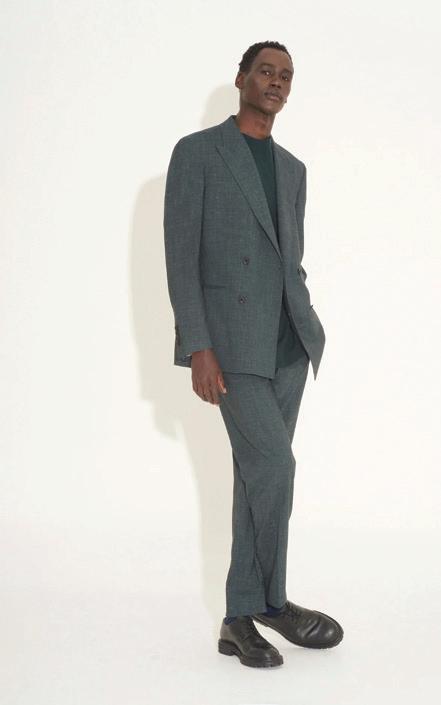

PLATFORM
Stacy Chan, founder of the new Platform store on Marylebone Lane, on collaborating with designers, telling stories, and choosing to dress mainly in black
Interview: Ellie Costigan
At Platform, we’ve created something unique. We sell pieces by multiple designers in store, but more than that, we work collaboratively with them. Some of our designers have been with me from the beginning and they don’t sell anywhere else. It’s a lovely community of people. If you make nice things but you don’t play well with others, you won’t be invited back!
I’m from New York, but I’ve lived in London for about 17 years. I took a course in handbag design at the London College of Fashion while I was working at a hedge fund in Mayfair and I realised it was the best part of my week – drawing, designing and creating. So, I started my own handbag brand. They’re made in Italy with Italian leather. I didn’t set out to be in the fashion industry, I just wanted to create something that was mine.
46 — MARYLEBONE JOURNAL / ISSUE NO. 105
A CLOSER LOOK STYLE
Isaac double-breasted two-piece suit
Below: Blake two-piece suit
STYLE PHILOSOPHY
order, we don’t make much of each style, we work with small artisans, and when we need more, we make more. I’ve always struggled with the word ‘fashion’ because fashion by definition is transient. We’ve always tried to position ourselves in a different arena, where the clothes have a greater currency. Fast fashion is propelled by this idea that clothing can just be disposable, whereas a couple of times a week we get someone who’ll come into the shop and say, ‘I still have something from your dad’s collection from 30 years ago.’ People just hold on to them. It’s a different mindset.
Q: You’ve called the suit fashion’s ‘comeback kid’. What’s the freshest way to wear one now?
A: The tailoring world has changed dramatically in recent years. A suit used to be a garment that existed separately to the rest of your wardrobe, worn for business or for formal occasions. But it’s been adopted by a new demographic who have flipped it on its head and are wearing it in an anarchic kind of way. We’ve had a lot of clients who’d never worn a suit in their life, now choosing to wear one but in a very relaxed way, with a t-shirt and trainers; wide, louche silhouettes.
It’s the antithesis of a traditional, structured suit. I think there is an association with tailoring houses that ‘heritage’ means harking back to the past, but classic doesn’t necessarily mean standing still.
Q: What is it about the power of a sharp suit? Does good tailoring affect us psychologically?
A: Very much so. A lot of people liken a well-cut suit to body armour. I think the confidence comes from something fitting you so well, and the fact that you’re part of the design process; it’s a collaboration between tailoring house and
We only work with tiny businesses. The supply chain is usually one designer who does everything – they’ll be the one who goes and gets the silk from the factory and takes it to the maker.
I consider myself a boring dresser. When I worked in finance I wore a lot of colour –it was my only creative outlet. Now I can wear anything I want, I find it’s easier just to wear black. There are things in the store I wouldn’t necessarily wear – things with a lot of pattern, for example –but I still love them and I know they will look very cool on somebody else.
I’m self-funded, so there’s no pressure to take on brands that don’t fit with Platform’s ethos, which centres on quality and sustainability. I hate that word, though: what does it really mean? Here, it means everything in the store is made from natural materials – silk, cashmere, wool, organic cotton, linen –or recycled polyester.
All the jewellery in the store is made to a particular quality standard. It’s usually vermeil, which is a sterling silver base with two microns of gold plating – though a lot of our designers are plating with three microns to make it stronger. Or it’s solid gold. A
lot of the jewellers do bespoke things as well.
We have three staff here at all times – oftentimes it’s me – and at least two of them are designers. It means you get to hear the stories behind the brands and the pieces from the designers themselves: the fact it’s a mother-daughter team, or why there are four birds on a tea towel and what they represent. You just don’t get that level of detail in a regular store.
I’m just so grateful for our new, permanent space on Marylebone Lane – I don’t think any other landlord would’ve given it to us, as I’m sure there must have been much bigger brands competing for it. But The Howard de Walden Estate knew the concept and seemed
to have a special place in their heart for what we do.
A lot of people want to shop sustainably but find the cost differential shocking. There was a survey that said people are willing to pay something like £10 extra for a sustainable garment, which is nothing. So, I try to find things people will think are beautiful, that just so happen to fit with our sustainable ethos.
One of the designers who has been with us for a long time is Valentina. She’s based in north London and does zero-waste knitwear, making everything by hand on an antique knitting machine. She’s starting with a cotton collection this summer, then in winter everything is cashmere. She rescues surplus yarns from UK family-run factories,
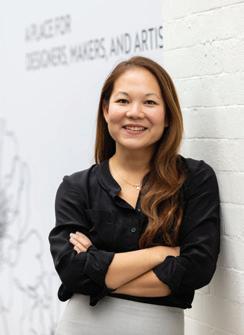
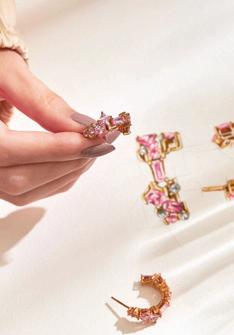
so her studio is piled high with different yarns. She has a really cool, funky style.
It’s not easy to get people to come shopping in person, but I believe you need to see and touch a product to understand the quality of it. The problem is, sometimes the experience can be very soulless. I think what people love about the store is, they feel a connection to what they’re buying, because they know the story behind it. It makes people excited about shopping again.
All our dresses have pockets, because it’s mostly women designing things – women want pockets! And we design for ourselves.
PLATFORM 49 Marylebone Lane, W1U 2NT platform-store.com >

47 — MARYLEBONE JOURNAL / ISSUE NO. 105
A CLOSER LOOK STYLE
Left to right: Stacy Chan; Juvetti lab-grown gemstones; Valentina Karellas zero-waste knitwear
client. Since we opened our store in 2018, we’ve been able to engage with our clients on a much deeper level than we did when we used to sell wholesale. It’s been a really interesting process for us in terms of listening to people and building our brand DNA – and, in a sense, problem solving. I know it’s an odd way to approach design, but we think about what our clients actually need in their wardrobes, given how lifestyles have changed and how people operate now. That’s how we’re always trying to evolve.
Q: You’ve dressed an incredible rollcall of stars for the red carpet. Who have been your careerdefining clients?
A: We asked the actor Paapa Essiedu to host the Special Recognition Award and he wore archive Joe Casely-Hayford from 1980, tweaked so that it fit him perfectly. It was wonderful to see him wearing something from several decades ago, looking so modern, because I think that proves the point about longevity. We also have a strong connection with the music industry, and it’s nice that we’ve often dressed artists at pivotal moments of their careers, such as James Blake winning his first Grammy or Sam Smith getting their first Brit Award. But it’s not necessarily about people being famous. On a personal level, I get just as much joy – if not more – from cutting someone a suit for their wedding day. It means that we’re a small part of the most important day of someone’s life, and that really resonates with me.
Q: How is life on Chiltern Street right now?
It’s very buzzy. Whenever the sun comes out, all these people seem to emerge from somewhere! Oliver Spencer has joined us recently which is a nice addition, and we currently have our second collaboration with Sunspel in store, which was completely born out of us being Chiltern Street neighbours.
I bumped into the guys a lot and it felt like a natural synergy, combining Sunspel’s cloth with our tailoring. It feeds into our idea of ‘soft’ tailoring being part of your relaxed, everyday wardrobe.
Q: Your wife, interior designer Sophie Ashby, designed your Chiltern Street store. Does it feel like an extension of your home?
A: Yes, we pretty much designed it around that idea. Often when I go into luxury stores, they’re quite austere and intimidating. We just wanted to create the warmest environment we could, and we came to the conclusion that emulating
Ezra relaxed tapered-leg trousers
our apartment was the natural way to make someone feel relaxed. So, my wife set about creating this wonderful little world. The store is very small, but the intimacy is part of its charm. And everything is for sale – the furniture, the artwork, not just the clothing. We once had a client – who wasn’t even a client yet – come in, sit downstairs in the fitting room and read a book for half an hour. Then he left without buying anything. It was a wonderful moment.
CASELY-HAYFORD
3 Chiltern Street, W1U 7PB casely-hayford.com

48 — MARYLEBONE JOURNAL / ISSUE NO. 105 A CLOSER LOOK STYLE

MY WORLD SUN LOCKET DINNY HALL, £275 dinnyhall.com
THE EDIT

TOQUILLA STRAW JESSE HAT AGNÈS B, £225 agnesb.co.uk
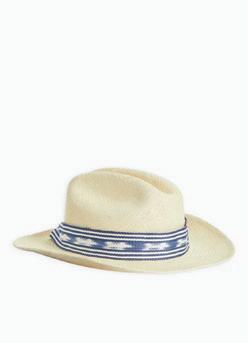
SOFT HOBO BAG BY ISAAC REINA MOUKI MOU, £720 moukimou.com
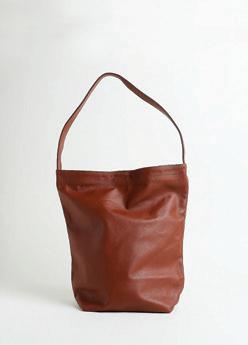
EMILIA SANDALS LA PORTEGNA, £195 laportegna.co.uk
‘SWIRL’ BANDEAU SWIMSUIT PAUL SMITH, £145 paulsmith.com
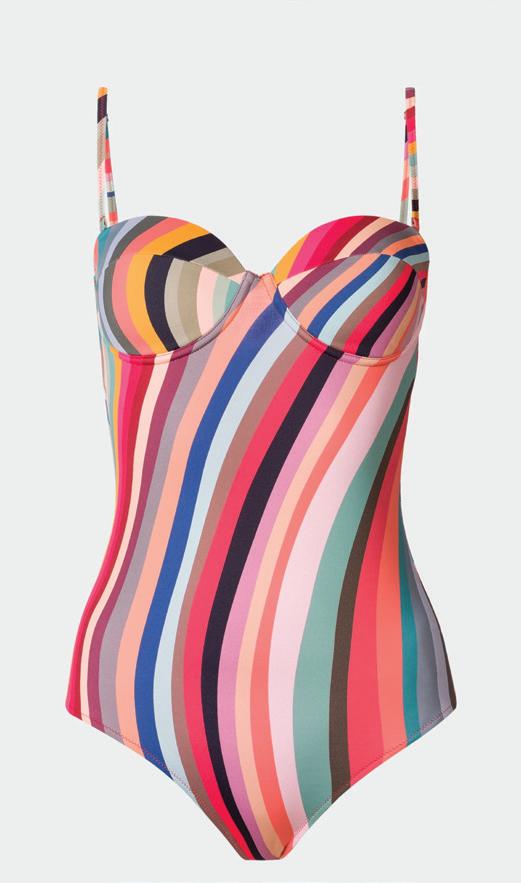
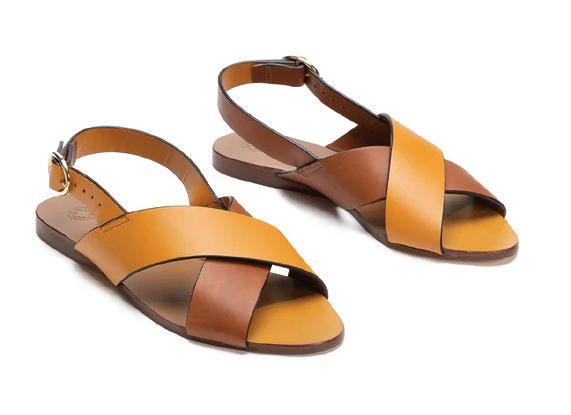
NURA IRREGULAR PEARL FRIENDSHIP BRACELET MONICA VINADER, £150 monicavinader.com
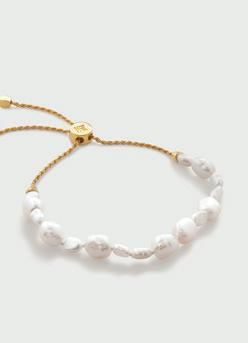
TROUSERS OSKA, £219 gb.oska.com
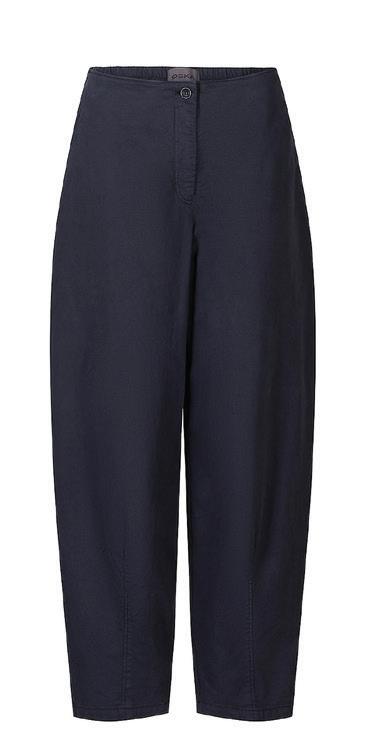
LEMTOSH SUN MOSCOT, £325 moscot.com
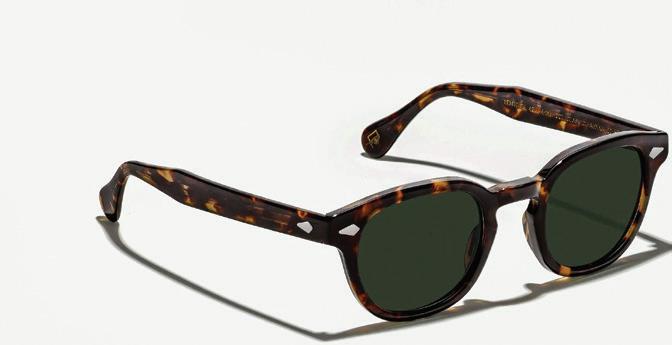
50 — MARYLEBONE JOURNAL / ISSUE NO. 105 A CLOSER LOOK STYLE







IN MARYLEBONE FOR BABIES & TODDLERS FROM 6 MONTHS TO 3 YEARS OLD WITH THE PARENT / GUARDIAN Littleexplorerslondon.co.uk (+44) 7584245750 Littleexplorerscamplondon@gmail.com
DAYS
FRIDAY BOOK NOW 51 — MARYLEBONE JOURNAL / ISSUE NO. 105
SENSORY PLAY SESSION
TIMINGS : 9:45AM - 10:45AM | 10:45AM - 11:45AM
: MONDAY | WEDNESDAY |
FLORAL TESTIMONY
Annabel Lewis, founder of VV Rouleaux, on a hat named after a famous flower garden
There are 110 hats in our VV Chapeaux collection – all individual, all made by me, and all inspired by Madge Chard: an eccentric milliner my mother worked for in the 1950s. I still have the vintage collection of silk flowers my mum would have used, and I’ve based my collection on them. Some of the flowers are lily of the valley in palest yellow, while others are quite white, so we’ve been hand painting them in beautiful shades. Matching colours to an outfit is our speciality. We start with a base that suits the customer – our hats are all headbands, or comb or elastic, so they don’t need fitting. We have 20 to 30 shapes all blocked by a man called Archie, who’s been doing this for years, and we finish and embellish them here.
Some hats are named after gardens, some are named after racecourses, and some are named after amazing ladies like Carmel Snow, who used to edit Harper’s Bazaar in the 20th century. One of my favourites is Vita’s Garden, named for the garden at Sissinghurst Castle created by poet and
writer Vita Sackville-West. It’s a round straw percher with multi-coloured vintage flowers, so it’s easy to wear and has a lovely texture. It’s the sort of hat that goes with anything: there’s a shop down the road called Ella Boutique which sells the most beautiful handpainted Italian dresses, all beautifully floaty and soft. They’d match this perfectly beautifully, especially with a ribbon around the waist to accentuate one of the hat’s colours. It could also be worn with a sharp tailored suit – that’s how we’ve styled it in the picture. Millinery is an amazing profession, but people often don’t have time to get a bespoke hat. We do bespoke hats in three days. People come in and say: “I’m going to an event in a couple of days and I just want a little something.” And I say: “No, dress up! You’ll be surrounded by people wearing fabulous dresses and hats, so you need to go for it.” This collection makes that fun and easy.
VV ROULEAUX
102 Marylebone Lane, W1U 2QD vvrouleaux.com
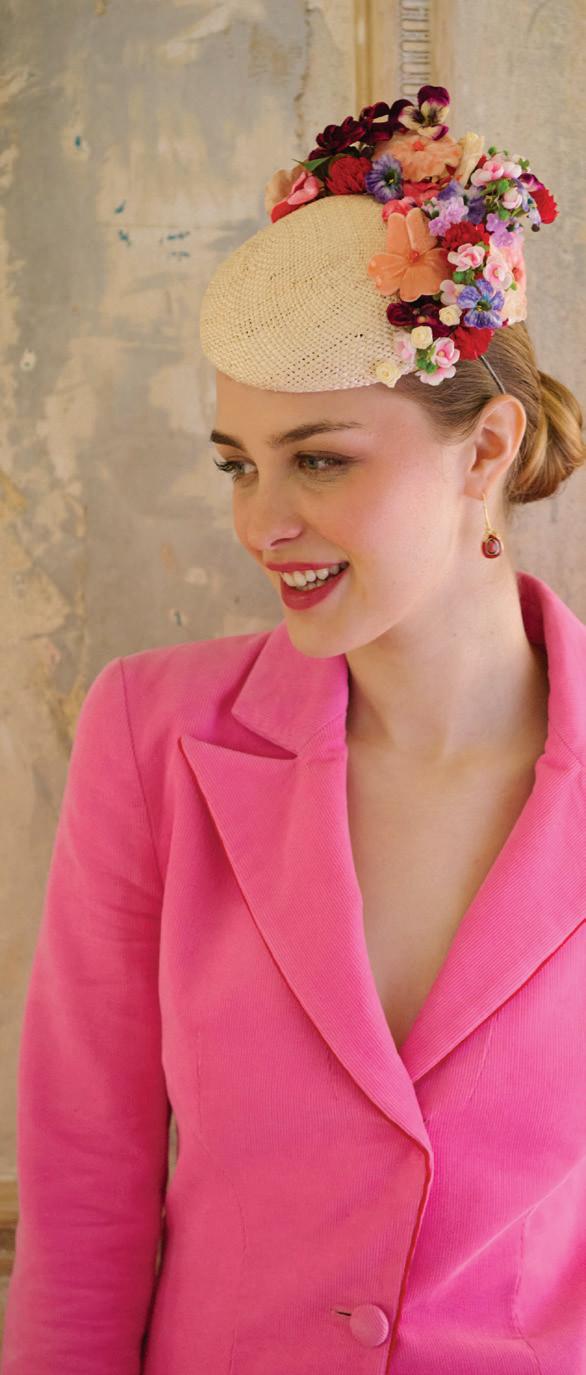
THE LOOK 52 — MARYLEBONE JOURNAL / ISSUE NO. 105
A CLOSER LOOK STYLE


53 — MARYLEBONE JOURNAL / ISSUE NO. 105 A CLOSER LOOK STYLE
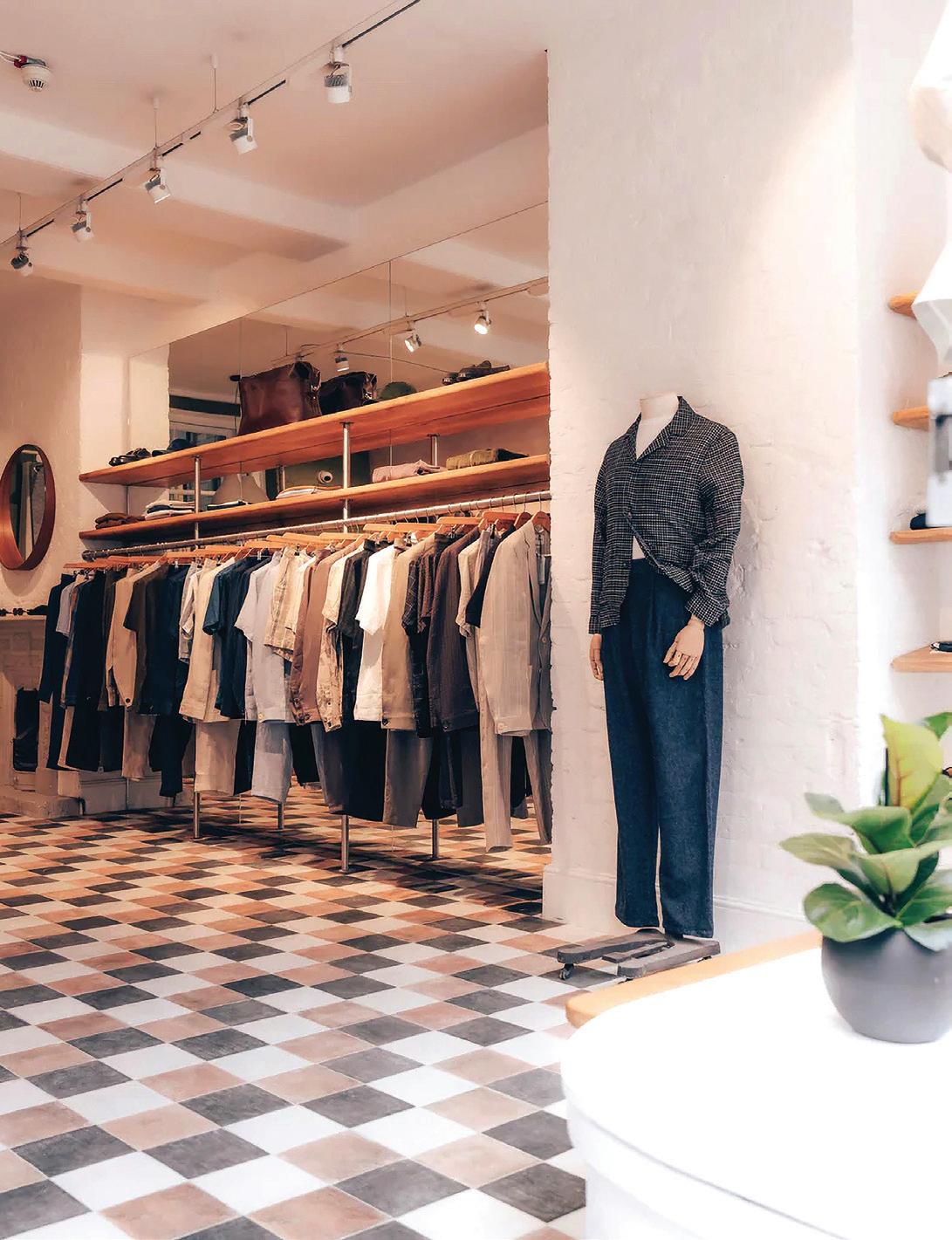
Oliver Spencer
Oliver Spencer has opened a new store on Chiltern Street, its fifth in London, adding to the street’s burgeoning reputation for high-quality menswear. Designed by young London-based architect Will Barker and furnished by Another Country, the Crawford Street furniture brand, the new boutique re-uses materials from other stores and showrooms, balancing a distinctive new aesthetic with a repurposing of the past.
OLIVER SPENCER
39 Chiltern Street, W1U 7PP oliverspencer.co.uk
NEW ARRIVAL
54 — MARYLEBONE JOURNAL / ISSUE NO. 105 A CLOSER LOOK STYLE
NEW
Expert skincare by leading clinicians

The Devonshire Clinic in the heart of Marylebone is a private dermatology clinic. Our clinic’s expert team led by Dr Conal Perrett, Consultant Dermatologist & Dermatologic Surgeon, provides expert opinion, diagnosis and treatment solutions for a wide range of medical dermatological conditions such as acne, psoriasis, rosacea, dermatitis, eczema and skin cancer.
According to the British Association of Dermatologists, as many as one in four people suffer from a skin condition that could be helped by a dermatologist.
In addition to expertise in treating skin disease, we also appreciate the importance of achieving optimal cosmetic outcomes for our patients. Working alongside our team of skin specialists here at The Devonshire Clinic is our Laser and Aesthetic Practitioner, specialising in non-invasive facial and body treatments. We use the latest technology to improve the visible appearance of skin whether it’s reducing the effects of sun exposure such as pigmentation, lines and wrinkles, improving facial redness or acne scarring.
At The Devonshire Clinic we offer a bespoke service to ensure each treatment precisely meets your needs and expectations leaving you feeling comfortable and reassured.
To find out more visit thedevonshireclinic.co.uk
Get in touch
020 7034 8057
info@thedevonshireclinic.co.uk
to arrange a no-obligation consultation quoting ‘Marylebone Journal’ We look forward to welcoming you to our clinic
SANDALS
‘Sun’s out, guns out’, the expression goes. But if you’re looking for a more accurate measure of heat, the sight of sandals would perhaps be more telling. After all, those people with the aforementioned ‘guns’ will seize any excuse to display them – but the mercury surely has to top 25C to tempt regular people to show even a hint of toe. That said, these sandals could sway us even on a breezy summer’s day. Quality leather, classy buckles and straps, non-slip soles – they have almost everything. The only thing required now is probably a trip to your nearest nail salon.
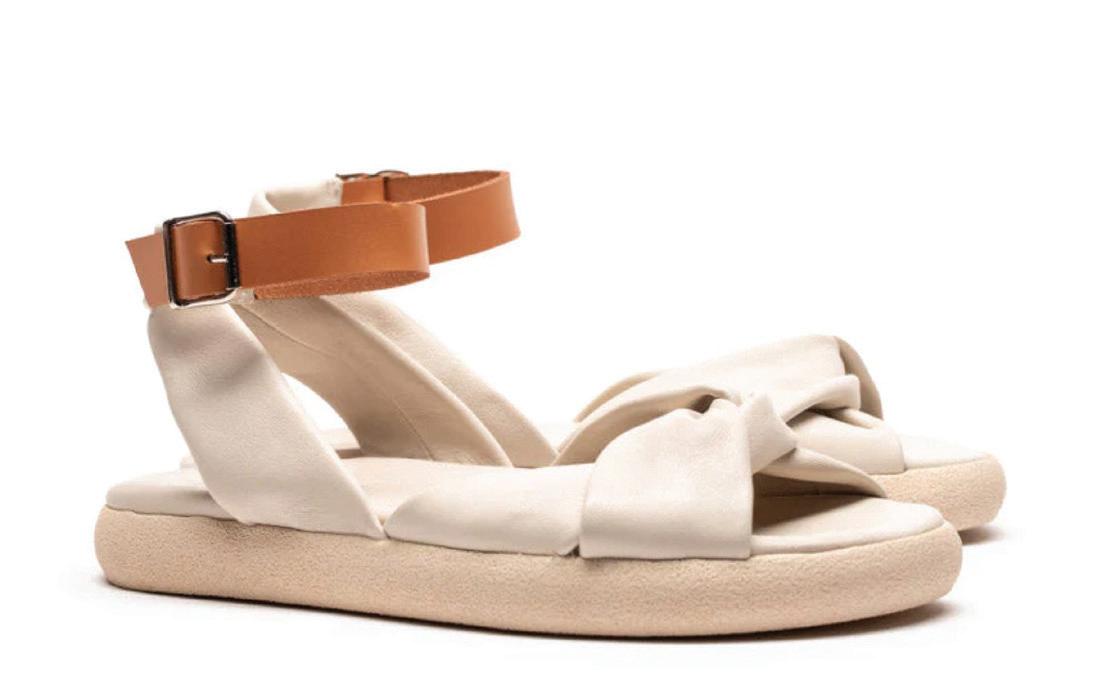
THREE OF THE BEST 56 — MARYLEBONE JOURNAL / ISSUE NO. 105 A CLOSER LOOK STYLE
WRAP
OFF-WHITE LEATHER
SANDALS TRACEY NEULS, £245 traceyneuls.com
Few designers marry comfort, style and individuality better than Tracey Neuls, and these sandals have all three in spades. Cross straps come in the softest leather, and the flat, micro-foam sole is at least as comfortable as your mattress. Neuls designed them as a “throwback to childhood pairs of easy sandals you don’t have to overthink”, and these shoes will make you feel as footloose and fancy free as a kid in the school holidays.
DELIA SANDALS TIGER OF SWEDEN, £349 tigerofsweden.com
“They just work” is what everyone says of a Delia recipe, and the same could be said of these shoes.
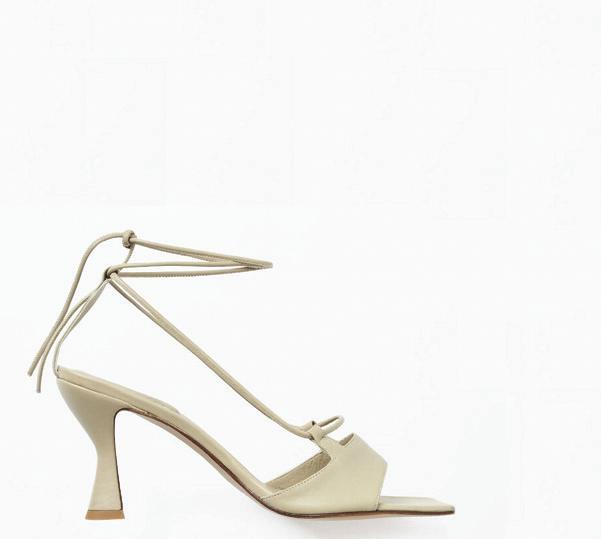
Designed in Sweden and made in Portugal, the chances of them ever adorning the feet of Britain’s most beloved cook are as slim as their straps, but the style is as reminiscent of the 1990s as the name. The 9cm heel might sound imposing, but their soft, Nappa leather and wide toe render them approachable –comfortable, even, with those tubular straps securing the ankle in a neat shape.
ARIANNE LEATHER SANDALS WITH STUDS GERARD DAREL, £145 gerarddarel.com
Practical enough to walk to the pub in and stylish enough to continue on to dinner, these versatile sandals are the chiropractic equivalent of a day-to-night dress or a good trench coat. The rubber sole is non-slip, the plain brown leathers are selected and worked to create items that will last over time, and the glinting golden studs and cute buckles elevate them into sandals which will turn heads while keeping your feet on the ground.
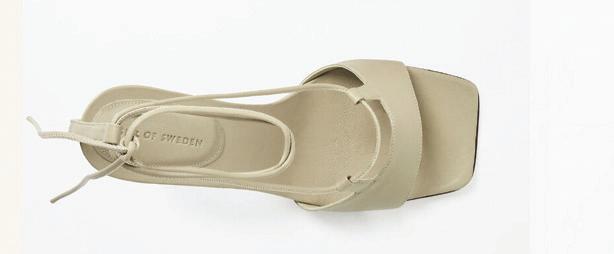
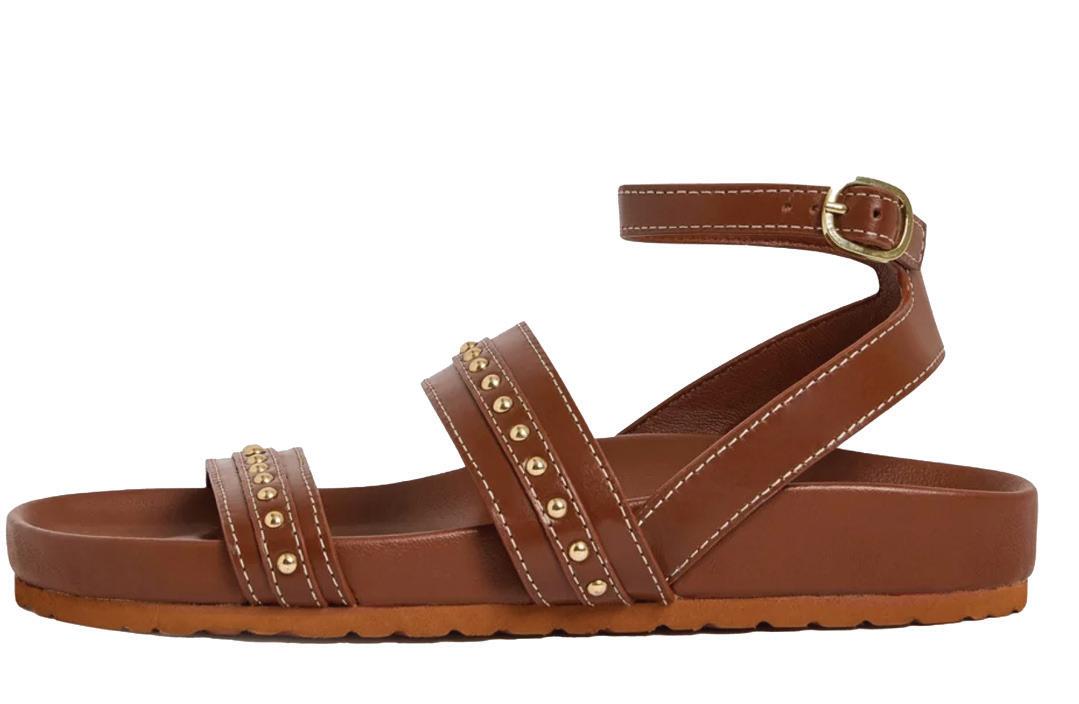
57 — MARYLEBONE JOURNAL / ISSUE NO. 105 A CLOSER LOOK STYLE
2. 1.
3.
ANATOMY OF A DESIGN
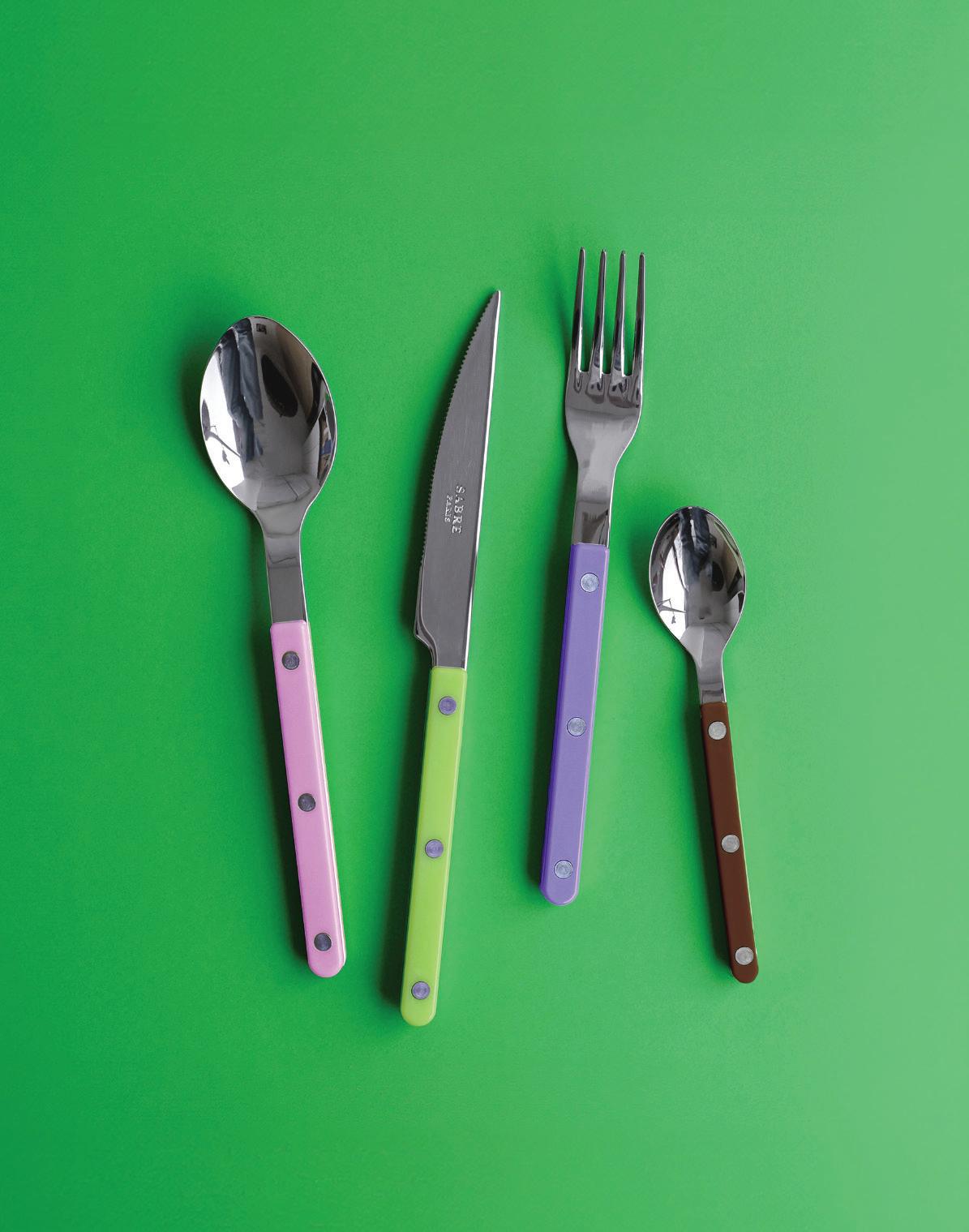
BISTROT CUTLERY RANGE
Pascale and Francis Gelb, the founders of Sabre, on a collection that sums up the unique approach of their French cutlery brand
Interview: Viel Richardson
Requirement
Francis: The requirement for cutlery is very basic: it is a tool to eat with. But that is not what Sabre is about. I want our cutlery to be part of our customers’ design life. My father owned a large goldsmiths company and I developed a passion for cutlery. When we started Sabre, flatware – what the industry calls cutlery – was either formal and boring or colourful and cheap. There was nothing in between. I
for something stylish but still familiar and maybe not too expensive. The Bistro range reflected this feeling.
Inspiration
Pascale: With cutlery, people can be very traditional – you have to follow certain rules in terms of size, length, number of prongs. You cannot be too creative or people will not buy the pieces. The challenge is to be creative enough while still meeting the customers’ expectations.
Francis: Expressing our inspiration can be tricky. At trade shows other manufacturers display their flatware with crockery in the traditional way. When we first created cutlery with daisies or coloured dots on the handles, I remember saying to Francis: “That style of presentation won’t work for us, it does not reflect who we are.” So, we displayed the flatware on brass. We sometimes display the Daisy collection in a flower pot. We want people to really appreciate the look of the pieces and connect them with the complete home environment.
Process
wanted to create cheerful, simple, elegant and highquality pieces. I couldn’t do this within the family company, so Sabre was born.
Pascale: I didn’t know anything about this field when we started, which for me was an advantage. I was free to create designs based on how I was feeling and what the culture I lived in was suggesting. The Bistro design came just after the financial crisis of 2008, when everything was disrupted. People were looking
Pascale: The first thing to say is that the physical quality of our flatware is beyond question. Yes, our main focus is the design, but this is pointless if the pieces do not stand up to use. Sustainability is also important to us, so when designing Bistro we looked for a production process with the least possible waste material. In the end, that decision determined the shape. We stamp the pieces from a metal sheet in a top-to-toe arrangement. This produces almost no wastage but really constrains the shapes available to you.
Francis: For the patterned handles we use fabric inlaid in acrylic. We put the fabric on a white base and then we inlaid it with clear acrylic. The acrylic is probably half a millimetre thick. Because we have fabric printed to our specification, the design possibilities are endless. We can create any design, but we
58 — MARYLEBONE JOURNAL / ISSUE NO. 105 A CLOSER LOOK HOME
are always looking for new production techniques.
Materials
Pascale: We try as much as possible to use dishwashersafe materials and this really limits what we can use. At the moment, for the handles it’s mainly acrylic and nylon. We sometimes use wood – teak and bamboo, for example. But bamboo cannot be put in a dishwasher, so we don’t use it a lot. This means we don’t have a wide palate of materials. For the metal, we use 1810 stainless steel, which is very durable, so dishwashers are not an issue. While it is a limiting factor, being dishwasher safe is a must for the majority of our collections. It is often the first question customers ask when they see something they like. The price comes later, because if the answer is no then the piece drops out of the story. It can sometimes be frustrating, because we are always looking for new materials and sometimes we find things we like, but they fall at this hurdle.
Philosophy
Pascale: We want to be a brand that says something about our customers’ lives. At its heart Sabre is not a kitchen brand, it is a lifestyle brand. We know how to make highquality flatware, but that is only the beginning of the story. Francis: In our shops, customers can choose what handles they want on their pieces. When deciding on the handles, our sales staff will have conversations about the colour of the curtains, the colour of the chairs, the decoration of the rooms, even the personality of their family members. It’s really fun for both them and the customers. It’s interesting that the choices do follow fashions – when pink was the season’s colour, we sold more pink cutlery – but our customers can mix and match designs and really show their individuality. That is want we always wanted to achieve.
SABRE
52 Chiltern Street, W1U 7QU sabre-paris.co.uk
SENDAN TOKUSA SQUARE CUP JAPANESE KNIFE COMPANY, £9 japaneseknifecompany.com

WINE CUP MUD AUSTRALIA, £43 mudaustralia.com
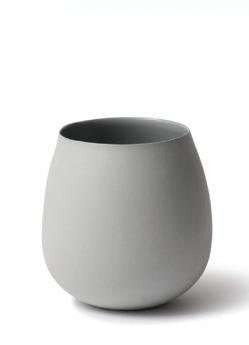
BOLLENGLASS DESIGN LIQUOR
GLASS MOUKI MOU, £45 moukimou.com
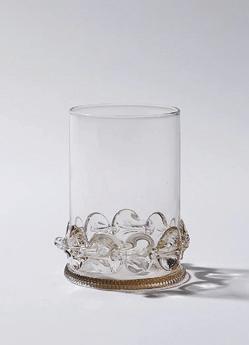
THE EDIT SIX DRINKING VESSELS
ENAMEL TUMBLER LABOUR & WAIT, £8 labourandwait.co.uk
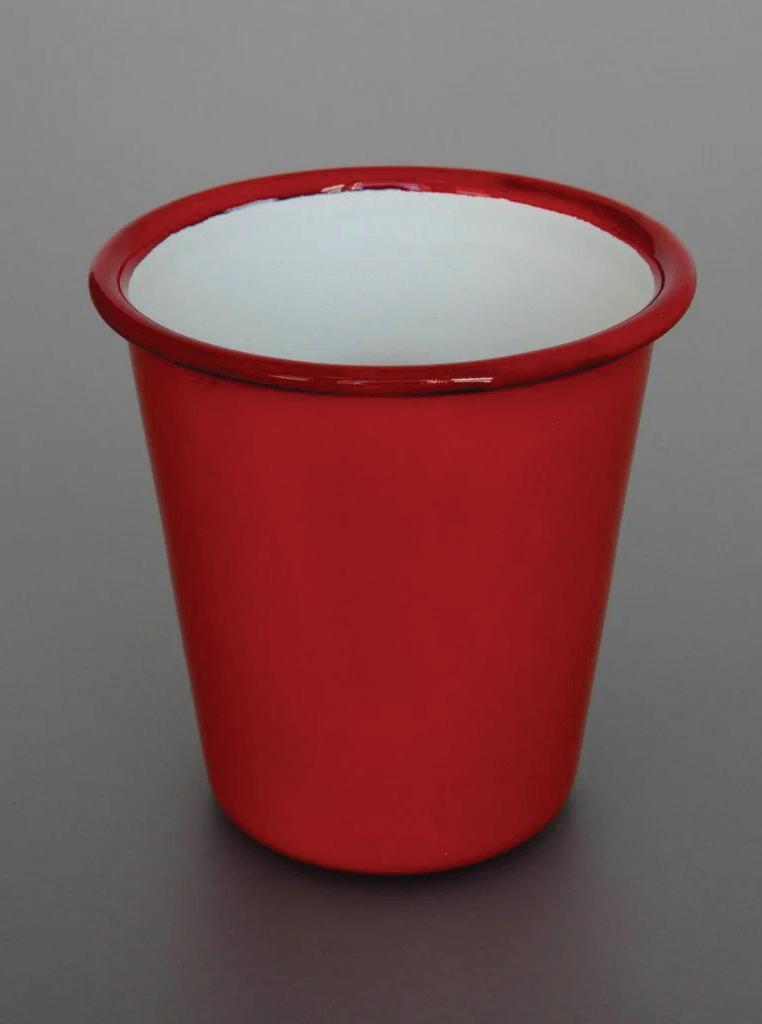

GREEN
DAVID MELLOR, £18 davidmellordesign.com
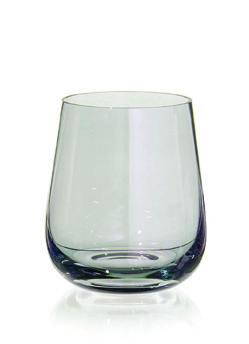
59 — MARYLEBONE JOURNAL / ISSUE NO. 105
A CLOSER LOOK HOME
EMBASSY
TUMBLER
HASAMI X MONOCLE LARGE MUG SET MONOCLE, £60 monocle.com
HANDS ON
Julien de Richeville, the UK head of Martine de Richeville, on a manual therapy that helps clients reconnect with their bodies
Q: Tell us about the Martine de Richeville method. Who is Martine?
A: Martine de Richeville is my mother. She created her treatment 25 years ago in Paris. I won’t say her age here, because she wouldn’t like that, but I can say that she’s still working 12 hours a day, five days a week, and she loves it. The treatment she created is a combination between many things she has studied throughout her life. She’s a trained psychologist –she studied psychology in university, so the treatment is rooted in that. Somatic psychology is her field of expertise – at the end of the day, everything you’re carrying, all your trauma, all your burdens, all your stress, is affecting your body. She also absorbed lots of traditional Chinese medicine, and several massage techniques. That’s how she developed the ethos.
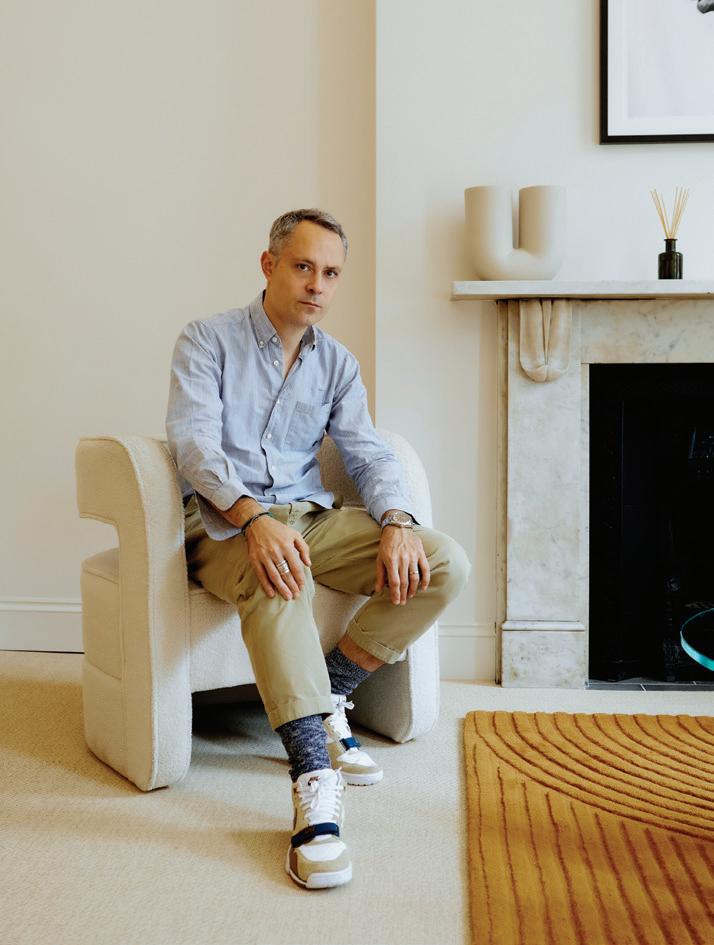
Q: So, what does the treatment involve?
A: It is a manual therapy. We work the skin down to its deepest layer, down almost to the muscle, to the fascia basically. We try to find with a specific hand motion what’s blocking inside the skin. The idea is to restore a good balance of circulation and soft texture of the skin. We also work a lot on the stomach. We have people who have a bit of a sluggish digestive process and feel a bit bloated, and it tends to help a lot.
Q: You promote the method as having aesthetic benefits, particularly with cellulite. How does this manifest?
A: Some of the benefits are visual, with the smoothness of the skin, the reduction of inflammation and the reshaping of the body. But even when clients mostly come for aesthetic purposes, they end up getting much more than that – it gets them on the path to reconnect with their body, basically. When you see that your body’s responding to a therapy, when you’re starting to see some improvements, it makes you feel better about yourself as well. So, that’s the idea of the process.
Q: How do people find those initial sessions?
A: So, the first session is not a walk in the park, let’s put it that way. It’s not like a massage – it’s like a proper skin workout, basically. When you start working on an area which is inflamed, it’s by nature sensitive. The idea is that as you start softening the tissues and helping the circulation go through, little by little the inflammation reduces, and the pain reduces as well. It takes a few sessions to get used to it, but then it’s quite pleasant at some point.
Q: Is part of the problem the terrible postures we adopt through modern life and work?
A: The worst we do to ourselves is being stuck on our laptops all day. That’s when things start hardening a bit and we need to reopen our bodies, recreate movement. Most new clients, I invite them to talk through their day basically, just be mindful of how and why they are tense. Can I do something? Can I breathe a little bit more? Can I reopen my posture? The idea is to reprogramme them in some way. For example, breathing through the stomach is something people mostly don’t do. They might do it in the yoga studio, but when they come back out, they completely forget. Breathing through your diaphragm will activate your lymphatic circulation, it will help with the digestion and it will make you more relaxed. But if you’re not doing it consciously, it will not happen. That’s what differentiates us from machineorientated spas, where they just plug you into a machine. We help you reconnect. If you’re not involved with your own body,
60 — MARYLEBONE JOURNAL / ISSUE NO. 105 A CLOSER LOOK WELLBEING
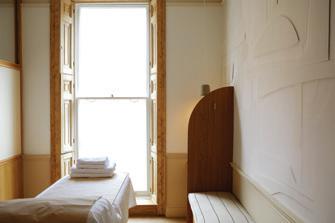
if you’re not connected to your own body, nothing will happen.
Q: Is there specific training that your therapists undertake?
A: Yes, my mother started to train people in the early 2000s basically, and after a while she gained a training license in France from the French government. And so, she’s then been training her own staff and a few licensees as well. Across the world, we are now a multinational venture. We have, like, 30 therapists working with us, employees and licensees.
Q: What are you looking for in a therapist?
A: Empathy, sincerity, a bit of strength in the hands. I have been recruiting and training quite a few people, and I immediately know if the person is going
to do the trick or not. The way they put their hands on you tells you immediately. Sometimes as soon as you shake their hand, you’re like: “Sorry, no.”
Q: What persuaded you to follow in your mother’s footsteps?
A: I’ve been doing this for the last 12 years now. I came from a very different background – from a finance job. My future wasn’t made for finance, to be fair. It was my first job, I did it as a young man, it was pleasant, but I find this work much more elevating and much more in tune with my own self – to work with people and help people, which feels good. It’s just a satisfying job to do.
MARTINE DE RICHEVILLE
42 Manchester Street, W1U 7LW uk.martinedericheville.com
NEW
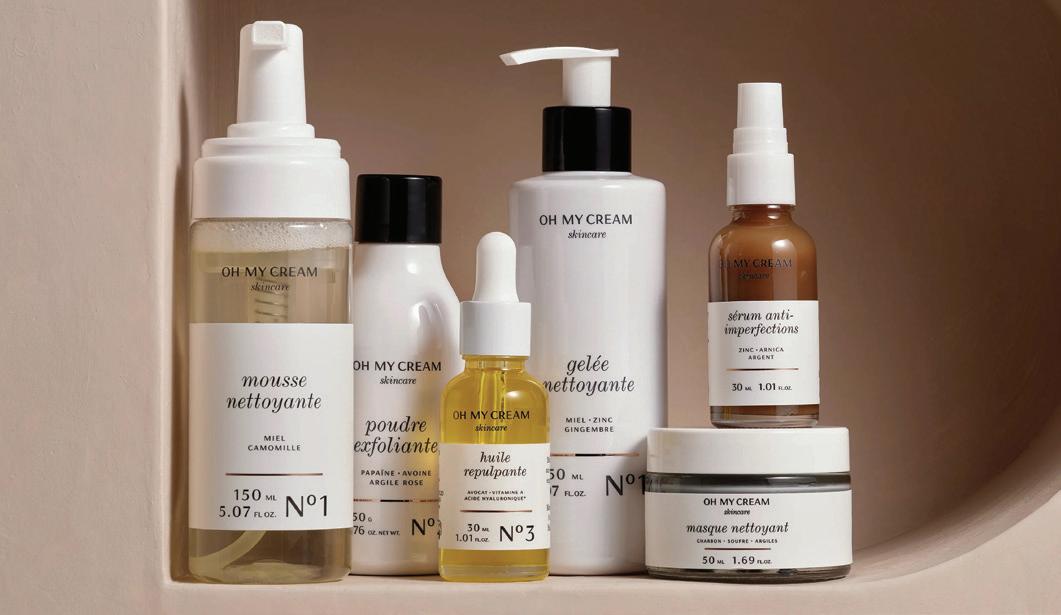
Oh
My Cream!
Founded in Paris in 2013 by Juliette Levy, the Oh My Cream! beauty concept store has rapidly become a fixture of France’s more picturesque shopping streets, offering its own range of skin, hair, body and makeup products, as well as carefully chosen complements from brands that share a similar approach. “Our mission is to give all women access to alternative beauty; cleaner, more expert and more inspiring,” says
Juliette. “Cleaner because we believe in transparency and clean formulas, more expert because expert advice is our strength, more inspiring because we shouldn’t have to choose between the good and the beautiful.” Oh My Cream! is opening this summer on New Cavendish Street.
OH MY CREAM!
24 New Cavendish Street, W1G 8TU ohmycream.co.uk
NEW ARRIVAL 61 — MARYLEBONE JOURNAL / ISSUE NO. 105 A CLOSER LOOK WELLBEING
62 — MARYLEBONE JOURNAL / ISSUE NO. 105 A CLOSER LOOK HEALTHCARE
SAVE YOUR SKIN
Dr Conal Perrett, consultant dermatologist and founder of The Devonshire Clinic, on an old technique that remains at the leading edge of skin cancer surgery
Interview: Viel Richardson
Q: What is Mohs micrographic surgery?
A: It was first developed by Dr Frederic Mohs in the late 1930s and early 40s as a way of removing certain types of skin cancer. It aims to remove the minimum amount of healthy surrounding tissue while removing the entirety of a tumour. It has become the gold standard technique for removing skin cancer tumours.
Q: When would this technique be used?
A: It is suitable for all skin cancers but is especially suited to high-risk areas. These are locations where
there is a risk of compromising a bodily function or leaving the patient with unsightly scarring in sensitive places once the tumour is removed – places like the neck and face, particularly around the eyes, ears, nose and mouth, and the genitalia and fingers. Also, for potentially recurrent or more aggressive tumours.
Q: What makes Mohs so effective?
A: To understand this, you have to first look at the usual process for removing a tumour. In a standard excision surgery, we cut out the tumour with a safe margin of around 6-7mm to try to ensure we remove all the cancerous cells. This is then sent to a pathology laboratory, where a pathologist examines the edge of the specimen to see if there are any cancer cells present. Unfortunately, because of the way the tumour specimen is prepared, the pathologist only examines about 1 per cent of the tumour. With Mohs micrographic surgery the whole of the tumour is examined, giving you a much more accurate result.
Q: Take us through the Mohs procedure.
A: It breaks down into two sections: surgery and pathology. We give the patient a local anaesthetic and mark out the site with 1mm leeway around the margin of the tumour. We then take high-resolution photographs. I’ll remove the tumour and put a dressing over the area, and the patient will be taken to a special waiting area. A specialist biomedical scientist from our pathology laboratory will take and prepare the specimen, which I’ll then examine under a microscope. I will examine the entire margin of the tumour. If it’s clear, we will show the patient a picture of the wound and discuss different options for reconstructing it. Once we’ve made a decision, I will reconstruct the defect, cover it
with a dressing and the patient can go home.
Q: What happens if the specimen is not clear?
A: This is where we come to the heart of what makes Mohs so effective. If there is still some tumour present, I can identify exactly where this residual tumour is located. The patient is then brought back into theatre, I will explain the results of the first stage of Mohs surgery and then remove more tissue from the identified place, again taking as little skin as possible. We then repeat the pathology process. If it’s clear, we reconstruct the defect. If the specimen is still tumour positive, we repeat the tissue removal. This continues until the specimen is tumour free. The whole procedure can take several hours, but while this can make it time and resource intensive it is well worth it for the increased effectiveness.
Q: What is the success rate of this technique?
A: If you have Mohs micrographic surgery for a skin cancer, it gives the lowest risk of recurrence –the risk of the cancer returning is less than 1 per cent in five years. In terms of cure rate it’s close to 100 per cent. For more complex tumours, that rate comes down, but not by much at all. If you compare that number to radiotherapy or to the standard excision surgery, the risk of recurrence for those procedures is around 10 per cent within five years. You can see that for the patient, it’s really worth giving up the extra time this procedure takes.
Q: Why is it that you go to such significant lengths to remove so little tissue?
A: As I mentioned, these procedures can often take place in the head and facial areas, so it’s important to remove as little tissue as possible in order to minimise the >
63 — MARYLEBONE JOURNAL / ISSUE NO. 105 A CLOSER LOOK HEALTHCARE
“I enjoy operating. I really like the immediacy of the process – the patient has a tumour before the surgery, and afterwards it’s gone.”
find that the tumour has spread much wider under the skin. It is something we warn people about when discussing the possibilities. What looks like a tumour a few millimetres across could lead to the removal of several centimetres of skin tissue.
Q: How do you go about repairing the holes?
cosmetic and functional impact on these important anatomical sites – whether that’s eating, drinking or facial expressions. We have to remove the skin cancer, but we must also remember that those functional and aesthetic outcomes can have a significant impact on the patient’s quality of life after the procedure.
Q: What size of wound is a patient likely to be left with after the surgery?
A: On average, most on the head, neck and mouth are about 1-1.5cm, but it is possible to have much larger defects – I have seen some that were 10cm across. Although some skin cancers grow very slowly – the commonest one, basal cell carcinoma, is a really slow grower – any growth at all is significant. On the face, even a few extra millimetres matters. Your nose, for example, is a very small area, so a few extra millimetres means that the wound can require a more extensive reconstruction.
Q: Do you have a clear sense before the operation starts of what the eventual size of the defect will be?
A: No, you don’t. It can be very difficult to judge the spread of the cancerous cells. It is possible to have a small spot on the surface but
A: The simplest option is to pull the skin in from either side and stitch it closed, which can work very well. Sometimes that doesn’t work, as it may impact nearby structures, such as distorting an eyelid or a lip. In this situation, we might do what’s called a flap repair. This means you take nearby skin – think of it as using a skin reservoir – and move it to close the hole left after tumour removal. This can be very effective. Alternatively, we can carry out a skin graft, taking some skin from behind the ear or the arm. Sometimes we simply leave a wound to heal on its own – that’s called secondary intention healing and all it requires is regular dressings. It works very well in certain parts of the body.
Q: What about for larger defects?
A: On the rare occasion that I feel the post-surgery defect is too large to reconstruct under local anaesthetic, we will arrange for the reconstruction to be undertaken under general anaesthetic by one of the consultant plastic surgeon colleagues in the practice. This happens either on the same day or the next day. If we know beforehand that we’ll need a plastic surgeon or head & neck surgeon, they will be programmed into the schedule when we plan the procedure. Whatever the level of defect repair, the patient will come back to have the wound checked and dressings changed until it is completely healed.
Q: Is there anyone for whom this procedure would not be viable?
If a patient is very frail, we might consider if this is the right option. They could be in and out of theatre over several hours, or even a whole day, which can be physically and mentally wearing. In such circumstances, we might instead arrange for radiotherapy with one of my clinical oncology colleagues. Or we might perform a traditional removal – this may have a higher risk of recurrence, but the risk is still relatively small.
Q: What about patients who also have other conditions?
A: We often work closely with a patient’s other clinicians, especially in the realm of medications. I once had a patient with very severe Parkinson’s disease who was denied surgery previously as their involuntary movements would have made the prodecure quite challenging. We liaised with their neurologist to adapt the medication regime so that during the operation there was virtually no movement at all. It worked very well, the tumour was removed, and the patient’s Parkinson’s wasn’t compromised.
Q: What do you enjoy most about what you do?
A: I work mainly with patients with complex cancers and really enjoy participating in research. It’s intellectually stimulating to be at the cutting edge of the field. I also enjoy operating. I really like the immediacy of the process –the patient has a tumour before the surgery, and afterwards it’s gone. But it is the relationships you develop with your patients that are really special. I’ve known some for 15 or 20 years because their condition means new tumours inevitably develop. Getting to know them and seeing their lives develop over the years is a hugely satisfying part of my job.
THE DEVONSHIRE CLINIC 16 Devonshire Street, W1G 7AF thedevonshireclinic.co.uk
Refer your p Consul within 48 Treatment management Diagnostics Bowel Blood in Abdominal 64 — MARYLEBONE JOURNAL / ISSUE NO. 105 A CLOSER LOOK HEALTHCARE
Walk-in Breast Screenings in Marylebone
At King Edward VII’s Hospital we know that worrying about your health can be upsetting and frustrating.
Our Breast Unit offers a comfortable and modern clinic to have your breast screening, with specialist staff on hand to put your mind at ease and answer all your questions.
• Book your private breast screening at a time that suits you
• Walk-in availability Mondays 8am – 6pm
• Pre-booked appointments Tuesdays – Friday 9am – 5pm
• Save your time – book your appointment before work, after work or on your lunch break.
“I
attended the breast unit for routine tests. Everybody was extremely caring, relational and pleasant. I was seen quickly and I felt I was in very competent hands. The environment was quiet and relaxing. It was a particularly good experience.”
Verified patient via Doctify

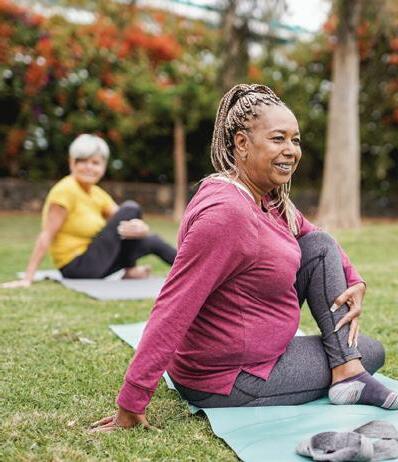
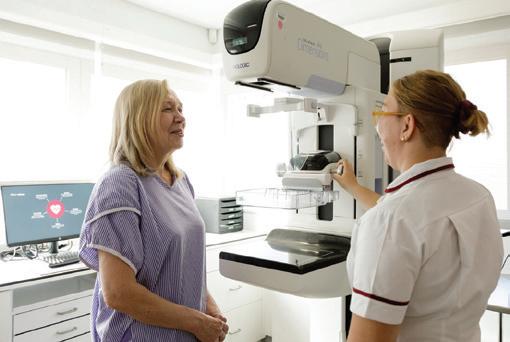

patient Patient Consultation hours E-learning module tment & management Physiotherapy services Diagnostics Doctor Bowel habit GP Services stools Health & Fitness Screening Services Abdominal pain Musculoskeletal pathway 48 48 48 Find out more at kingedwardvii.co.uk or call our friendly team on 0203 991 1182 Book your breast screening today
Rated Excellent on Doctify 4.83 out of 5 based on 3434 patient reviews
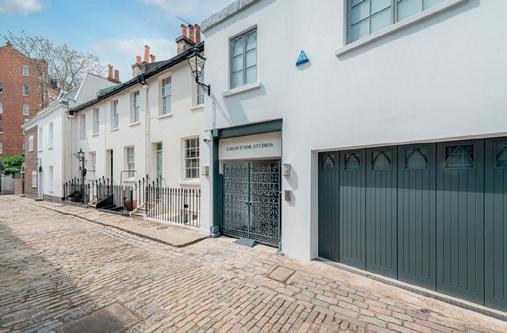
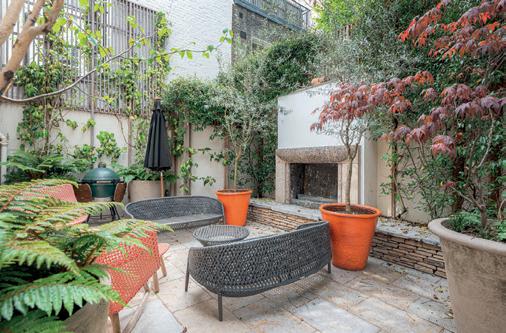
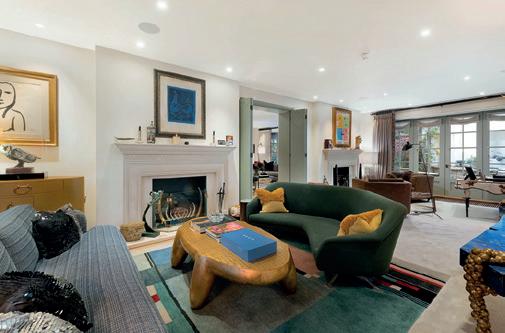
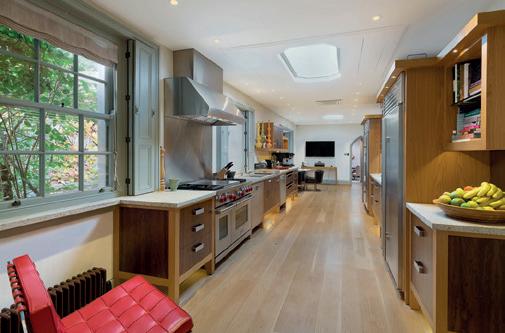
FOR SALE £28,000,000 Belgravia Grosvenor Studios OBPRIVATE.CO.UK @ OLIVERBERNARDPRIVATE @CHARLIEGIBSON_OB 4 6 1 GARAGE INTERNAL GARDEN COURTYARD FREEHOLD 7396SQFT

020 7486 6711
sales@mcglashans.co.uk
lettings@mcglashans.co.uk



WYTHBURN PLACE, MARYLEBONE W1H
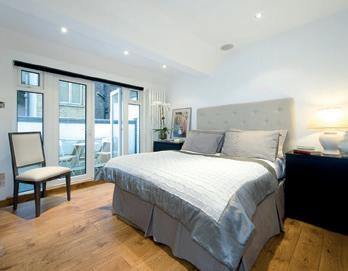
£2,200,000 STC Freehold
A unique contemporary newly built mews house, situated in a quiet cobbled mews close to Marble Arch, EPC – D, Council Tax (Westminster) Band G. Living room, dining room, kitchen, 2 double bedrooms, 2 bathrooms (1 en suite), 3rd single bedroom / home office, guest cloakroom, small decked terrace.
If you are thinking of Selling or Renting your home, please call us for a Free Valuation.
EXECUTIVE PROPERTY SPECIALISTS
107 CRAWFORD STREET, LONDON W1H 2JA WWW.MCGLASHANS.CO.UK For full info please refer to the website
MARYLEBONE LANE, MARYLEBONE VILLAGE, LONDON W1
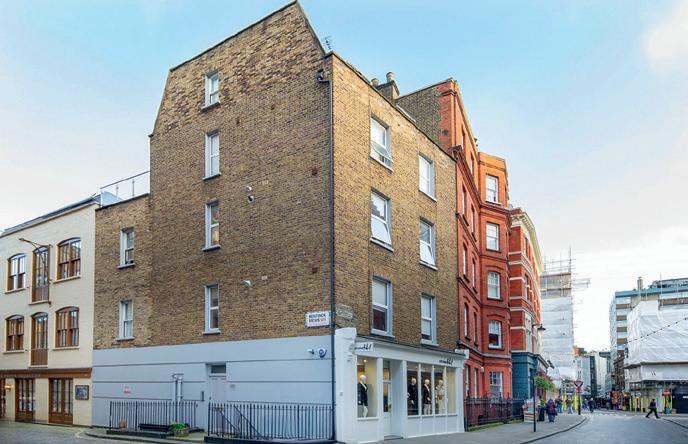
MARYLEBONE VILLAGE, LONDON W1
Unique top floor two-bedroom apartment located on Marylebone High Street.
A bright newly refurbished two-bedroom apartment located on the top floor with lift in the heart of Marylebone Village. The accommodation comprises of two double bedrooms, reception room, bathroom and separate kitchen.
The building is ideally located just a few minutes’ walk to Marylebone High Street with its fabulous restaurants, bars and high end boutiques. Bond Street Underground Station is a short walk away with Regent’s Park also nearby.
Unfurnished
£850 PER WEEK
Mixed-use investment building comprising one ground and lower ground floor retail unit, plus three residential two-bedroom flats (one with a roof terrace) on the upper floors, situated in the heart of Marylebone Village.
The building is favourably located on the east side of Marylebone Lane, at the junction with Bentinck Mews, in the heart of Marylebone Village. The area is well known for its wonderful array of amenities including shopping, restaurants and bars (Ivy Café, Conran, 108 Brasserie), healthcare practices and the green open spaces of Regent’s Park and Hyde Park.
Long leasehold 895 years
£5,500,000
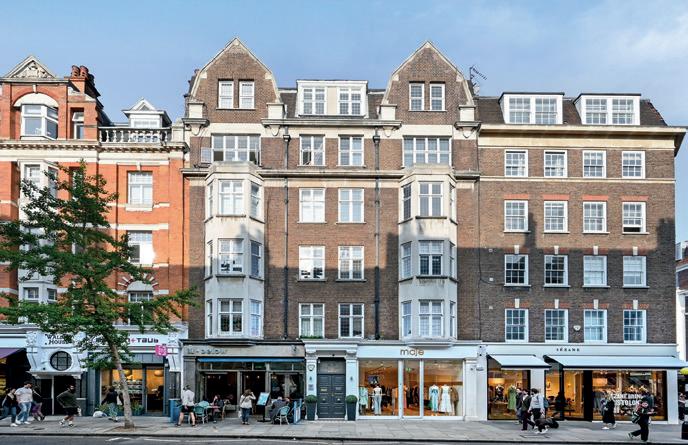
MARYLEBONE PROPERTY AGENCY ESTABLISHED 1981 jeremyjames@jeremy-james.co.uk 020 7486 4111 www.jeremy-james.co.uk MARYLEBONE PROPERTY AGENCY ESTABLISHED 1981 jeremyjames@jeremy-james.co.uk 020 7486 4111 www.jeremy-james.co.uk




Montagu Mansions
London W1U
Guide price £3,700,000
Recently refurbished three-bedroom apartment is located in one of the most sought-after Georgian red brick mansion blocks.
3 bedrooms • 2 bathrooms • 1,375 sq ft • Very good decoration • Share of freehold
Marylebone & Regent’s Park 020 7486 8866
marylebone@carterjonas.co.uk

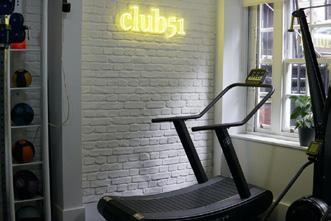



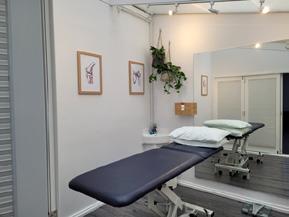
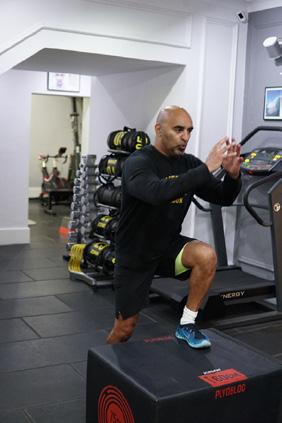







Intelligently Design uman Performance Programmes in a Discreet, Coach-Led Environment Personal Fitness Training Physio & Sports Therapy Sleep Coaching Performance Nutrition Medical Exercise Specialists C ENQUIRIES@CLUBFIFTYONE.CO.UK 020 3982 3856 CLUBFIFTYONE.CO.UK As Featured In E N Q U I R E N O W Personal Training Studio Intelligently Designed Health and Human Performance Programmes in a Discreet, Coach-Led Environment Personal Fitness Training Physio & Sports Therapy Sleep Coaching Performance Nutrition Medical Exercise Specialists Corporate Fitness ENQUIRIES@CLUBFIFTYONE.CO.UK 020 3982 3856 CLUBFIFTYONE.CO.UK As Featured In E N Q U I R E N O W Personal Training Studio Intelligently Designed Health and Human Performance Programmes in a Discreet, Coach-Led Environment Personal Fitness Training Physio & Sports Therapy Sleep Coaching Performance Nutrition Medical Exercise Specialists Corporate Fitness ENQUIRIES@CLUBFIFTYONE CO UK 020 3982 3856 CLUBFIFTYONE.CO.UK As Featured In E N Q U I R E N O W Personal Training Studio





































































































































































